


NON PROFIT ORG US POSTAGE PAID SAN ANTONIO, TX PERMIT 1001 SAN ANTONIO
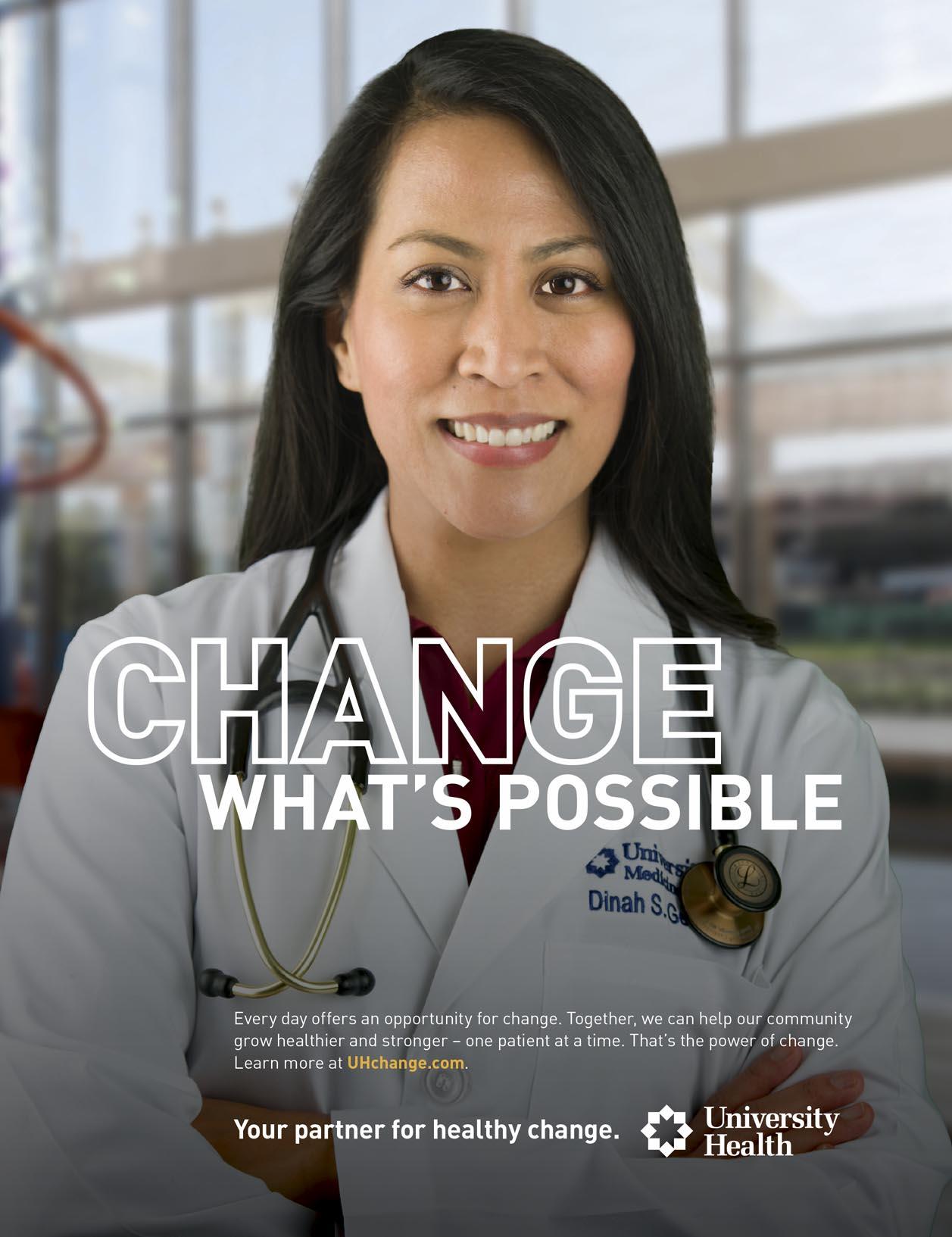
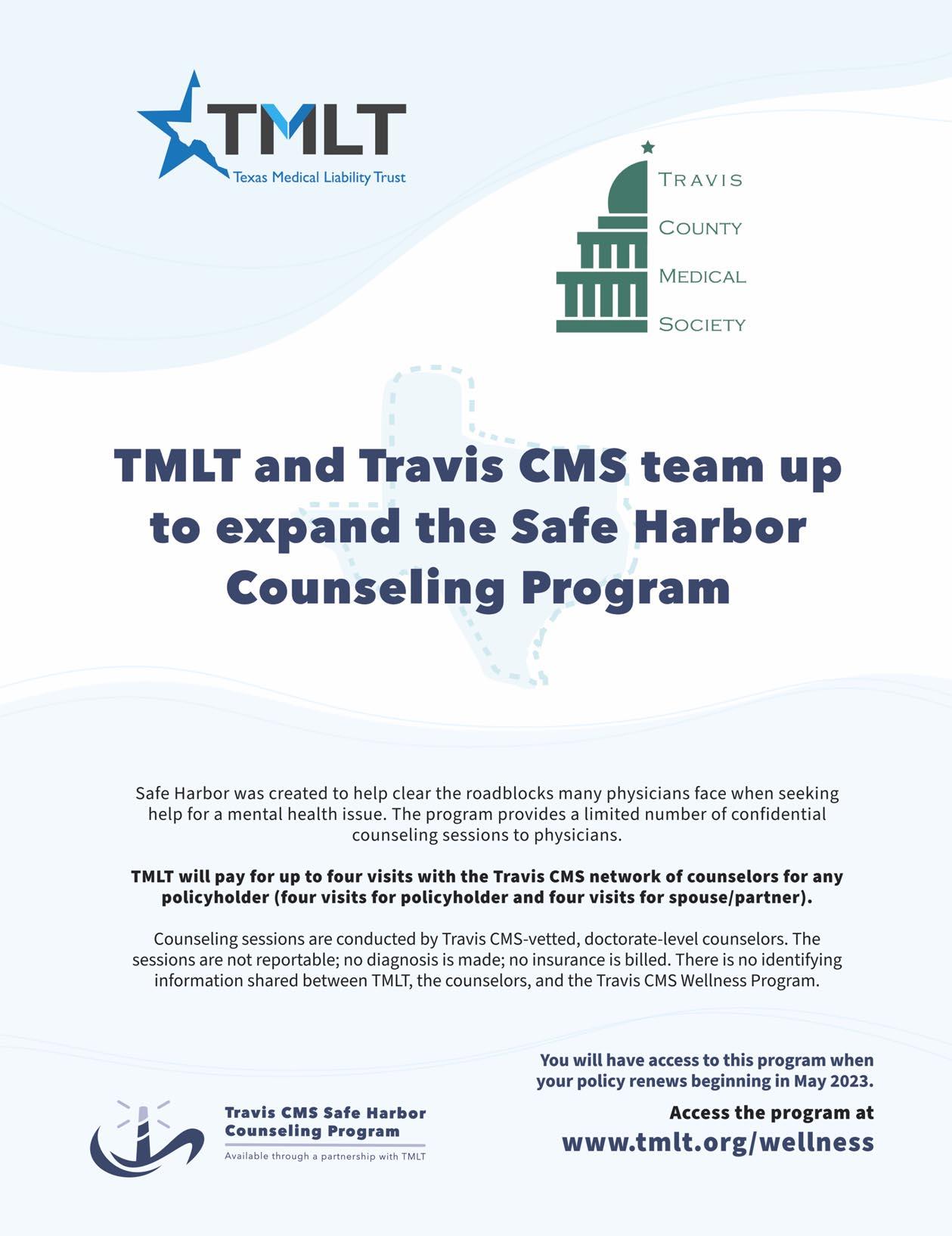
PuBLISHED By: traveling Blender, llC. 10036 Saxet Boerne, tX 78006
PuBLISHER


louis doucette louis@travelingblender.com
BuSINESS MANAGER: vicki Schroder vicki@travelingblender.com
ADVERTISING SALES:
AuSTIN: Sandy Weatherford sandy@travelingblender.com
MEN’S HEALTH
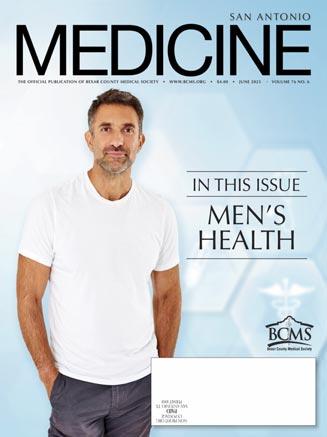
San Antonio Medicine is the official publication of Bexar County Medical Society (BCMS). All expressions of opinions and statements of supposed facts are published on the authority of the writer, and cannot be regarded as expressing the views of BCMS. Advertisements do not imply sponsorship of or endorsement by BCMS
EditoriAl CorrESpondEnCE: Bexar County Medical Society 4334 n loop 1604 W, Ste. 200 San Antonio, tX 78249
Email: editor@bcms.org
MAGAZinE AddrESS CHAnGES: Call (210) 301-4391 or Email: membership@bcms.org
SuBSCription rAtES: $30 per year or $4 per individual issue
AdvErtiSinG CorrESpondEnCE: louis doucette, president traveling Blender, llC.
A publication Management Firm 10036 Saxet, Boerne, tX 78006 www.travelingblender.com
For advertising rates and information
Call (210) 410-0014
Email: louis@travelingblender.com
SAN ANTONIO MEDICINE is published by SmithPrint, Inc. (Publisher) on behalf of the Bexar County Medical Society (BCMS). Reproduction in any manner in whole or part is prohibited without the express written consent of Bexar County Medical Society. Material contained herein does not necessarily reflect the opinion of BCMS, its members, or its staff. SAN ANTONIO MEDICINE the Publisher and BCMS reserves the right to edit all material for clarity and space and assumes no responsibility for accuracy, errors or omissions. San Antonio Medicine does not knowingly accept false or misleading advertisements or editorial nor does the Publisher or BCMS assume responsibility should such advertising or editorial appear. Articles and photos are welcome and may be submitted to our office to be used subject to the discretion and review of the Publisher and BCMS. All real estate advertising is subject to the Federal Fair Housing Act of 1968, which makes it illegal to advertise “any preference limitation or discrimination based on race, color, religion, sex, handicap, familial status or national orgin, or an intention to make such preference limitation or discrimination.
SAN ANTONIO: Gerry lair gerrylair@yahoo.com
For more information on advertising in San Antonio Medicine, Call Traveling Blender at 210.410.0014 in San Antonio and 512.385.4663 in Austin.
SmithPrint, Inc. is a family-owned and operated San Antonio-based printing and publishing company that has been in business since 1995. We are specialists in turn-key operations and offer our clients a wide variety of capabilities to ensure their projects are printed and delivered on schedule while consistently exceeding their quality expectations. We bring this work ethic and commitment to customers along with our personal service and attention to our clients’ printing and marketing needs to San Antonio Medicine magazine with each issue.
Copyright © 2023 Smithprint, inc.

SAN ANTONIO 4 SAN ANTONIO MEDICINE • June 2023
TABLE OF CONTENTS
prin tE d in tHE u SA
THE OFFICIAL PUBLICATION OF THE BEXAR COUNTY MEDICAL SOCIETY • WWW.BCMS.ORG • $4.00 • JUNE 2023 • VOLUME 76 NO.6
Medicine, a Paradigm Shift: Inevitable Antidote for the Chronic Disease Pandemic! By Bhoja R. Katipally, MD, MPH, FAAFP, DipABLM 12 Frontotemporal Dementia – The Lesser-Known Mind Thief By Monica J. Salas, MD 16 Benign Prostatic Hyperplasia Management By Christopher H. Cantrill, MD 18 SBRT for Lung Cancer: Achieving High Rates of Tumor Control and Improving Patient Outcomes By Douglas Lee, DO, Radiation Oncologist, GenesisCare 19 Varicose Veins... Not Just for Women! By Robert K. Thompson, MD, FACS 20 New Diabetes Garage Workshop Making an Impact Among Men in San Antonio By The City of San Antonio Metropolitan Health District 22 Relationships and Heart Health By Natalie R. Nyren, PA-C and Kit Bjella Kevin Powers, MD 24 Colon Cancer Rates in African American Males By Victoria Ayodele, Contributing author Yousef Salem 26 Primary Care Role in Preventing Strokes in Men By Morgan Lockwood, Corynne McEachern, and Madisyn Moak 28 BCMS President’s Message 8 BCMS Alliance Message 10 A Season of Change: What It’s Like to Graduate Medical School in 2023 By Niva Shrestha, third-year medical student at UIWSOM 30 The Last “First Tuesdays at the Capitol” of the Legislative Session By Melody Newsom, BCMS Chief Executive Officer and Executive Director 32 Preparing for the Unexpected – Trust and Estate Resources for Your Legacy By Blake Bratcher, Texas Partners Bank 34 In Memoriam 35 UTSA Alvarez College of Business Executive MBA Program Kicks-Off the 170th Anniversary Celebration of BCMS and its Members 36 Fiesta de Salud 38 BCMS Vendor Directory 40 Auto Review: 2023 Mercedes-AMG SL 63 By Stephen Schutz, MD 44 Recommended Auto Dealers 46
Lifestyle

ELECTED OFFICERS
John Joseph nava, Md, President
Brian t. Boies, Md, Vice President
Ezequiel “Zeke” Silva iii, Md, President-elect
John Shepherd, Md, Secretary
rajeev Suri, Md, Treasurer and Immediate Past President
DIRECTORS
Woodson "Scott" Jones, Md, Member
Sumeru “Sam” G. Mehta, Md, Member
priti Mody-Bailey, Md, Member
lubna naeem, Md, Member
lyssa n ochoa, Md, Member
Jennifer r rushton, Md, Member
raul Santoscoy, do, Member
Amar Sunkari, Md, Member
lauren tarbox, Md, Member
Jenny Case, Alliance Representative
ramon S. Cancino, Md, Medical School Representative
lori Kels, Md, Medical School Representative
robert leverence, Md, Medical School Representative
Keiko McManus, Md, Board of Ethics Chair
John pham, do, Medical School Representative
Cheryl pierce-Szender, Alliance Representative
ronald rodriguez, Md, phd, Medical School Representative
Col. Cecilia Kai Sessions-Carpenter Md, MpH, Military Representative
George F. “rick” Evans, Jr., General Counsel
Jayesh B. Shah, Md, TMA Board of Trustees
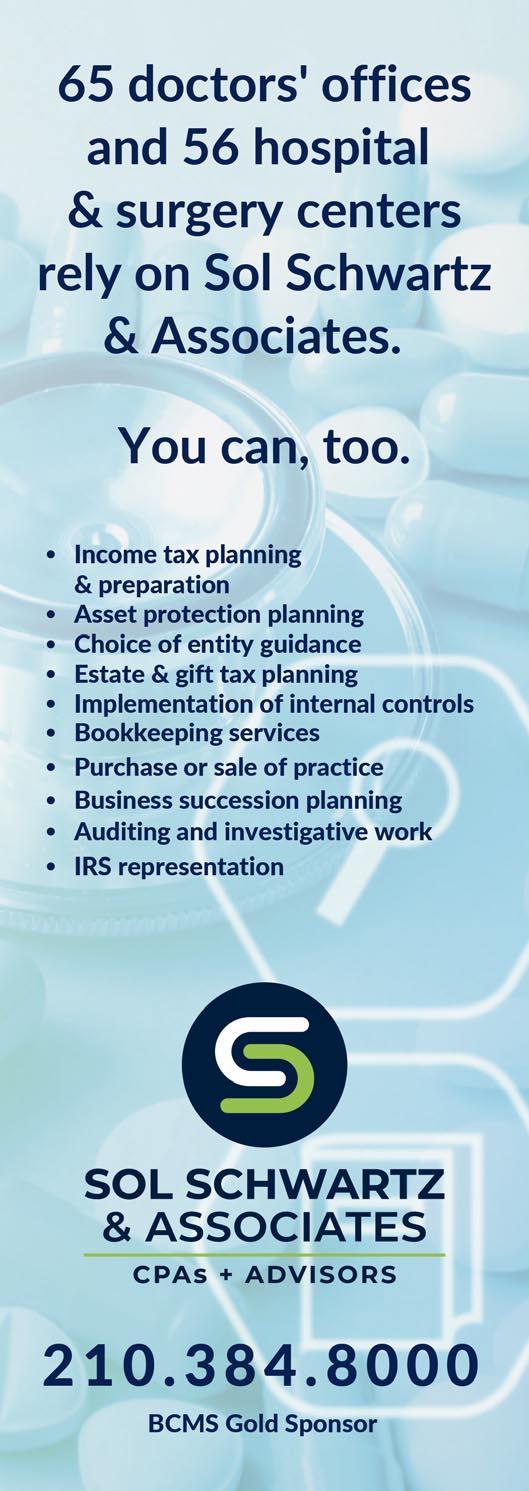
Melody newsom, CEO/Executive Director
BCMS SENIOR STAFF
Melody newsom, CEO/Executive Director
Monica Jones, Chief Operating Officer
Yvonne nino, Controller
Mary nava, Chief Government Affairs Officer
Brissa vela, Membership Director
phil Hornbeak, Auto Program Director
August trevino, Development Director
Betty Fernandez, BCVI Director
Al ortiz, Chief Information Officer
PuBLICATIONS COMMITTEE
norys Alexandra Castro-pena, Md, Co-chair
John Joseph Seidenfeld, Md, Co-chair
louis doucette, Consultant
david Schulz, Community Member
Elizabeth Clanton, Md, Member
Kristy Yvonne Kosub, Md, Member
neal Meritz, Md, Member
Jaime pankowsky, Md, Member
Alan preston, phd, Member
rajam S. ramamurthy, Md, Member
Adam v ratner, Md, Member
Faraz Yousefian, do, Member
Moses Alfaro, Student Member
victoria Ayodele, Student Member
tue Felix nguyen, Student Member
niva Shrestha, Student Member
Bethanne Bradshaw, Student Member
Andrew ta, Student Member
Monica Jones, BCMS Coo, Staff Liason
trisha doucette, Editor
6 SAN ANTONIO MEDICINE • June 2023
BCMS BOARD OF DIRECTORS

Male Physicians’ Health: The Good News versus The Bad News
By John J. Nava, MD, 2023 BCMS President
Even though entering the medical profession is a positive, fulfilling choice, it does have its risks. Exposure to infectious agents, radiation and toxins is possible. Despite these risks, physicians tend to have greater life expectancy than other professions. This result may not be surprising, since “physicians’ large amount of health-related education and high socioeconomic strata (as judged by education, income and occupational level) should lead to lower relative mortality”1. This was the conclusion of an article published in October 2000 in the Journal of Preventive Medicine1. Though there are limitations of this study, it provides some encouraging perspectives on physician mortality. “These findings should help to erase the myth of the unhealthy doctor. At least for men, mortality outcomes suggest that physicians make healthy personal choices.” It has also been observed that “physicians’ personal health habits may affect their patient counseling practices.” Perhaps the practice of saying “do as I say, not as I do” is becoming less prevalent. Let’s hope so, for the physicians. For their patients, it is encouraging that they are getting reliable lifestyle advice they can count on.
In this study, “the top ten causes of death for White male physicians were essentially the same as those of the general population, although they were more likely to die from cerebral vascular disease, accidents and suicide, and less likely to die from chronic obstructive pulmonary disease, pneumonia/influenza or liver disease than other professional White men.”
“Although this may be an artifact of inappropriate reporting, it is consistent with our finding of lower mortality rates from chronic liver disease and cirrhosis, and with findings that although physicians are less likely to completely abstain from alcohol than others, they may drink smaller amounts when they do consume. Physicians’ lower lung cancer PMR (proportionate mortality ratio) is also highly consistent with physicians helping to lead the smoking cessation movement for the past several decades.”
Suicide risk among males (as opposed to females) in general has always been a concern. As I was taught, males in general have a greater rate of success when they do attempt suicide, more frequently choosing firearms for self-injury. To be honest, I am rather ignorant about suicide risk among physicians. I have occasionally had to deal with suicidal patients in clinical practice as a primary care physician, but besides assessment and referral for prompt intervention and psychiatric follow-up, my knowledge base was lacking.
The suicide rate for male physicians cited in this study was 2.9%, well above the general population of 0.1%. More recently, other citations have reported the rate has increased to 4.0%. These numbers may be misleadingly high. A confounding factor may be that there are many more younger physicians due to growth in the total number of medical graduates over the past few decades who are less likely to die from chronic diseases. More research is needed, and is forthcoming.
BCMS Efforts - Physician Wellness Ad Hoc Committee
The recent COVID-19 pandemic has been implicated as one of the stressors to cause an increase in suicide rates among healthcare workers. The incidence of anxiety and depression in this population has been postulated to be increasing for the same reason. As a means to counteract these disturbing trends, the BCMS Physician Wellness Ad Hoc Committee has been formed. This group of physicians meets on the third Wednesday of each month and has been busy developing a resource guide for physician members, both online and virtual. In person activities are also being developed to enhance coaching activities that have already been introduced. Community-wide activities are being planned. Any interested member is invited to follow the activities of this group and consider becoming active themselves. For more information, the website can be located at www.bcms.org/phywellness.php.
As before, a valuable benefit for members of BCMS is LifeBridge, available to any member who needs to talk to a counselor confidentially. For more information, visit www.bcms.org/lifebridge/lbbcms.php.
References:
1. Mortality rates and causes among U.S. Physicians, American Journal of Preventive Medicine, Volume 19, Issue 3, pp. 155-159, October 2000
John J. Nava, MD is the 2023 President of the Bexar County Medical Society. He is interested in Primary Care, Clinical Research and Public Health.
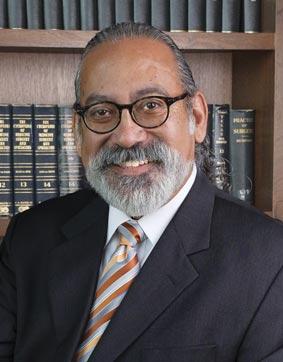
8 SAN ANTONIO MEDICINE • June 2023 PRESIDENT’S MESSAGE

BCMS Alliance Scholarships
By Jenny Case, MSN, MBA, RN

The Bexar County Medical Society Alliance (BCMSA) is a county chapter of the Texas Medical Association Alliance (TMA). TMA strives to protect the future of medicine through community service, legislative advocacy and providing a community of support through mentorship and lasting friends in the “Family of Medicine.” One of the ways BCMSA accomplishes this mission is by awarding scholarships to deserving medical and allied health students studying in Bexar County.
Professors and advisors from local universities recommend outstanding students for these scholarships, who are then vetted and awarded monies by the BCMSA Scholarship Committee (chaired by the Immediate Past President). Each year medical students from the UT Health San Antonio Long School of Medicine and the University of Incarnate Word School of Osteopathic Medicine are awarded the Medical Student Scholarship and the Hispanic Medical Student Scholarship. Allied health scholarships are awarded to undergraduate students, as well as to students in graduate programs such as nursing, physical therapy, pharmacy and speech pathology. Additionally, there are two memorial scholarships granted to allied health students in honor of Rebecca Christopherson (2015 President) and Sandra Vela (2017 Centennial Board Member) for their lasting impact on the Alliance.
Thanks to fundraising efforts and donations from the Alliance members over our 106-year history, we have raised and maintained our scholarship fund. Our 2017 centennial fundraiser alone netted over $40,000! TMA Foundation grants also generously match BCMSA medical student scholarships, allowing us to assist more students on their paths towards a career in medicine.
We are pleased to announce the 2023 Awardees. Hispanic Medical School Scholarship Recipient:
• Denise Nemeth from the University of the Incarnate Word School of Osteopathic Medicine
Medical School Scholarship Recipients:
• Daniel Kade from UT Health San Antonio Long School of Medicine
• Nina Nguyen from UT Health San Antonio
Rebecca Christopherson Memorial Scholarship:
• Moran Kingsbury from the University of Texas at San Antonio, studying Occupational Therapy
Sandra Vela Memorial Scholarship:
• Hailey Lechuga from the University of Saint Mary’s, starting Pharmacy school in 2024
Allied Health Scholarship:
• Emilio Cassaretto from the University of the Incarnate Word for Physical Therapy
“Thank you so much for the scholarship and all the work that the Bexar County Medical Society does. As a medical student, being connected to my community is at the core of why I wanted to become a doctor. Through this scholarship, I can continue focusing on ways to treat, care and advocate for our Bexar County residents.”
– Nina Nguyen
“I am very honored and thankful for the scholarship awarded to me by the Bexar County Medical Society Alliance. The scholarship will help me in facilitating my purpose of becoming a physical therapist. As a physical therapist I exist to empower and balance individuals to an active and knowledgeable healing approach, assisting in unlocking their OWN human potential!”
– Emilio Cassaretto
“I am sincerely honored to have been selected as the recipient of the Rebecca Christopherson Memorial Scholarship. I am very thankful for your generosity as this scholarship will support me in continuing my education in the field of Occupational Therapy, and obtaining a doctorate degree in Occupational Therapy. Your support and thoughtful gift are greatly appreciated.”
– Morgan Kingsbury
10 SAN ANTONIO MEDICINE • June 2023 BCMS ALLIANCE
Jenny Case, MSN, MBA, RN, is the 2023 Co-President of the BCMS Alliance.

Lifestyle Medicine, a Paradigm Shift: Inevitable
Antidote
for the Chronic Disease Pandemic!
By Bhoja R. Katipally. MD, MPH, FAAFP, DipABLM
Background: Advanced Medicine and Chronic Disease
Burden – A Paradox
Science and technology, advanced exponentially over the past few decades, brought some of the most sophisticated pharmaceuticals, medical devices and interventions that were beyond imagination until recently. Completion of the human genome project opened doors to a whole new frontier, precision medicine, where both diagnosis and management are guided and driven by genomics. Thanks to the COVID-19 pandemic, it pushed our limits to reengineer the doctor-patient interaction and workflow for the better. Innovative pharmaceuticals, procedures and vaccines virtually made us invincible from an array of major life-threatening emergencies, infections, trauma, acute issues and their complications, and to virtually even the pandemics.
In the light of such advancement, it’s easy to delude ourselves and celebrate as if modern medicine and the latest cutting-edge technology have a “pill for every ill” and a “procedure for every problem.” Unfortunately, the current rapid unsustainable explosion in global and national chronic disease burden (CDB) only dispels that assumption, questioning if we truly made any progress in understanding and treating the human ailments and simply lost our focus and were blindsided by unseen forces that are driving our society and lifestyles in the wrong direction. This very disconnect resulted in our expensive high-tech modern medicine working at its best for a wide range of life-threatening conditions but failing to make even a small dent in addressing the chronic lifestyle disease crisis, which is a true pandemic today.
Problem: Unsustainable Chronic Disease Burden and Cost of Care

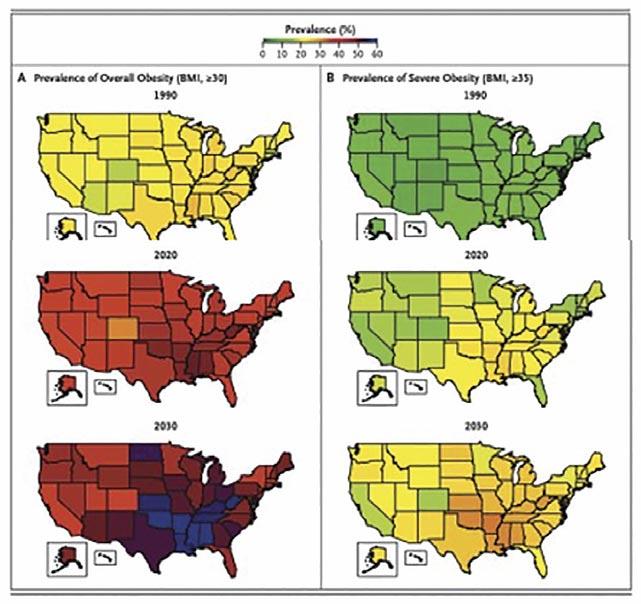
An arsenal of antimicrobials and vaccines gave us the victory over infectious causes that took millions of lives in the past century, but shifted the pendulum towards chronic non-communicable, lifestyle-related, metabolic diseases. Rapidly evolving technology not only gave us a safer and comfortable lifestyle but also industrialized the processes and disrupted our basic human habits and ways of living, including our nutrition, need for regular movement or physical activity, sleep and stress management.
According to the CDC’s 2020 leading causes of death report, 70 to 80% of the Top 10 leading causes of death are lifestyle related and easily preventable1,2. COVID-19, that took over a
million lives in the United States, was on the top of the list only next to heart disease and cancer. Institute for Health Metrics and Evaluation (IHME) described the recent global situation as SYNDEMIC, a combination of chronic diseases, social inequalities and the COVID-19 pandemic, as those chronic pre-existing conditions and social disparities set the perfect stage for the COVID-19 pandemic3.
12 SAN ANTONIO MEDICINE • June 2023
MEN’S HEALTH
Estimated Prevalence of Overall Obesity and Severe Obesity in Each State, from 1990 through 2030.
Prevalence of total diabetes as a percent of total population for each state for 2015, 2020, 2025, and 2030 based on the Diabetes 2030 Model (age adjusted to standard population).
While heart disease and cancer are the top two leading causes of death in the U.S., obesity, diabetes, poor nutrition, lack of physical exercise, poor sleep, stress and social determinants of health are the actual contributing root causes for them. The CDC described obesity as “a common, serious and costly disease” because prevalence of obesity in the U.S. is far beyond the global average and it costs the U.S. healthcare system $147 billion a year. In the U.S., one in five children and one in three adults are battling with obesity compared to one in eight worldwide. From 1999-2000 through 2017-2018, obesity (BMI ≧30) rates in the U.S. increased by 50% while the severe obesity (BMI ≧35) rates doubled. If the current global trends continue, about 2.7 billion adults are expected to be overweight and over a billion individuals will be obese worldwide by 2025. By 2030, one in two Americans are expected to be obese, nearly one in four would be severely obese, 29 states will have more than 50% of population obese while none of the states will have obesity rates less than 35%4,5,6.
According to the 2016 CDC report, median prevalence of diabetes rose from 7.8% in 2004 to 13.1% in 20167. And, CDC’s most recent data shows that about 88 million adults have prediabetes and over 37 million people have diabetes (11.3% of the U.S. population) while nearly a quarter of them were not unaware of their condition8. Diabetes incidence is estimated to increase by 54% by 2030, annual deaths attributable to diabetes will go up by 38% and the total cost will increase by 53% to more than $622 billion by 2030. Thus, the annual cost of CDB in our country is mounting to $3-4 trillion combined with about $200-$500 billion per disease every year. According to the CDC, 90% of the nation’s $4.1 trillion annual healthcare expenditures were spent on people with chronic and mental health conditions in 2021 alone9.
According to San Antonio Metro Health, men have a higher prevalence of obesity and diabetes and their complications in the San Antonio area. Prevalence of diabetes is much higher in San Antonio and the Bexar County area compared to that of the State of Texas. Men with diabetes have higher rates of hospitalization, diabetes-related amputations, COVID-19 infections and complications, and mortality in general in the San Antonio area10.
Solution: Lifestyle Medicine – If lifestyle is the source, where else do we find the solution to go from Illness to Wellness?
The Global Disease Burden (GDB)-2017 Study findings warrant our attention, suggesting if we truly want to tackle our current chronic disease burden and the morbidity and mortality linked to it, we must shift our focus from the Leading Causes of Death (LCOD) to the actual risk facts, i.e., the root causes for these diseases11
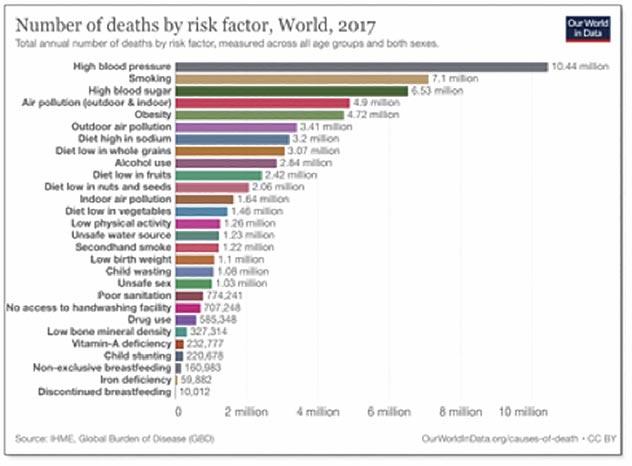

Poor nutrition, lack of regular physical activity, poor sleep and stress management are the lifestyle factors that play a vital
role as the root causes for most of the leading chronic diseases today. They trigger a cascade of metabolic dysfunctions, namely systemic inflammation, gut dysbiosis and insulin resistance just to name a few, that lead to endothelia damage, atherosclerosis, prediabetes, diabetes, etc., that in turn become the host of an array of complications. Consequences of poor lifestyle choices are not limited to metabolic syndrome and cardiovascular diseases but are proven to be directly linked to cancers, especially breast, prostate and colon cancers, autoimmune diseases, gastrointestinal diseases including metabolic associated fatty liver disease/non-alcoholic fatty liver disease (MAFLD/NAFLD), mental health problems, neurological diseases including Alzheimer’s diseases, etc.
Industrialization of dairy, farming, food production, packing and distribution that took place about 50 years ago left its footprint. The historic trend shows the point where a distinct surge and parallels were seen in both the average daily per capita food (calories) consumption and the start of the nation’s obesity and diabetes epidemic—the crisis that peaked and is overwhelming our healthcare system today.
Visit us at www.bcms.org 13
MEN’S HEALTH continued on page 14
Number of deaths by Cause and by Risk factor- World Stats, 2017
continued from page 13
About 80% of heart diseases and 60 to 70% of all leading causes of death are not just preventable or manageable through simple lifestyle changes but can potentially be reversed. Unfortunately, lifestyle recommendation has become a “wish” or a “lip service” as both patients and healthcare providers either don’t believe in its potential, or feel it’s more complicated to change our lifestyles rather than getting pills or procedures, or simply lack appropriate resources. It’s a true challenge, at least in the current practice model, which is designed and driven by other metrics, until we shift our focus from the reactive medicine to a proactive one that addresses the root causes deliberately and effectively.
terventions upregulated (turned-on) more than 450 anticancer genes and downregulated (turned-off) close to 50 cancer-promoting genes13
In a systematic review and meta-analysis of 47 studies, it was noted that physical inactivity is associated with increased all-cause CVD incidence and CVD mortality14. Dr. Dean Ornish, et al., showed in their Lifestyle Heart Study more than two decades ago that intensive lifestyle changes can reverse coronary heart disease in established CAD patients15.
In its position statement, ACLM suggests that “as incidence and prevalence of T2D continue to rise, the current best evidence from multiple intervention studies supports that remission achieved with intensive lifestyle modifications should become the preferred treatment and standard of care. To achieve remission, appropriate, therapeutic dosing of lifestyle modifications is necessary”16
Six Pillars of Lifestyle Medicine19:
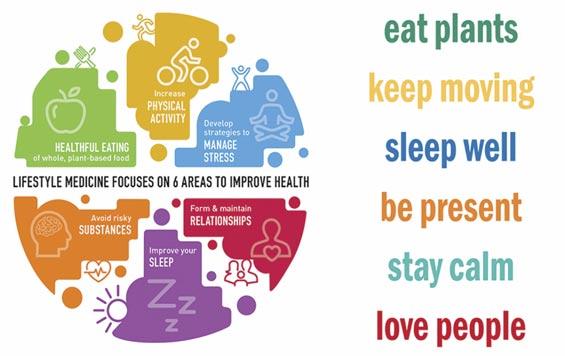
• EAT: Eat more plants and adapt to whole-food plant-predominant eating patterns. Choose low fat, high fiber, less refined plant-based foods loaded with complex carbohydrates and phytonutrients.
• MOVE: Incorporate regular physical activity into your life with two goals.
a. 150-300 minutes of moderate level cardio exercises per week such as walking, brisk walking or jogging, or 70 minutes of vigorous exercise per week such as running or biking.
b. Resistance/strength training at least twice weekly. Balance and stretching exercises are also recommended for more benefits.
• SLEEP: Six to eight hours of restorative sleep per night for the best physical, mental, cognitive and metabolic benefits.
Lifestyle Medicine, one of the fastest growing specialties both in the U.S. and internationally, was founded to meet that very need and serve as the missing link in our current healthcare system. The American College of Lifestyle Medicine (ACLM) defines Lifestyle Medicine as: “Lifestyle medicine is an evidence-based approach to preventing, treating and even reversing diseases by replacing unhealthy behaviors with positive ones—such as eating healthfully, being physically active, managing stress, avoiding risky substance abuse, adequate sleep and having a strong support system.” Those lifestyle interventions are the six pillars of Lifestyle Medicine12

Decades of research and multiple metanalyses showed the compelling evidence that simple lifestyle interventions not only prevent or manage a majority of the chronic diseases well but potentially reverse many of them including obesity, diabetes, cardiovascular diseases, autoimmune disease as well as many types of cancers. Family history and genetics were thought to be complete non-modifiable, but today we know that our DNA is not our destiny as the epigenetic research showed us that lifestyle changes can directly alter the behaviors of the genes on our DNA by modulating their expression and suppression like turning our them “ON” and “OFF” in the intended direction. Dr. Ornish’s GEMINAL Study on patients with Prostate Cancer demonstrated that simple lifestyle in-
• STRESS: Relaxation and better stress management through regular yoga, meditation, breathing exercises, journaling, gratitude exercises, mindfulness and a purpose-driven life go a long way.
• CONNECTIONS: Deep, nurturing, positive social connections reinforce the benefits from the rest of the pillars of lifestyle medicine.
• RISKY BEHAVIORS: Avoid tobacco, illicit substance use and highrisk health behaviors, limit alcohol and coffee, and beware of food addiction.
Call to Action: Paradigm Shift from Acute, Reactive, Sick Care Model to a Holistic, Proactive, Health Care Model
According to the recent reports, life expectancy in America had declined to its lowest in decades—the latest generation of Americans are expected to live shorter than their parents18,19
Designed around the acute care model, today’s modern healthcare system is, at its best, able to handle life-threatening emergencies and trauma through pharmaceuticals and surgical procedures but failing to tackle the chronic disease crisis, which requires root cause mitigation. With all the evidence pointing at our poor lifestyle as the root of all chronic disease, now is the time for a paradigm shift and re-examination of our current healthcare delivery model to incorporate lifestyle medicine and health behavioral interventions to change the future of our nation’s health.
14 SAN ANTONIO MEDICINE • June 2023
MEN’S HEALTH
ACLM's Six Pillars of Lifestyle Medicine
Ommen, et al., in their paper, “From Diabetes Care to Diabetes Cure— The Integration of Systems Biology, eHealth, and Behavioral Change,” urged that the need for effective lifestyle changes and interventions calls for change in the way we deliver the healthcare today20. We must redefine health; redesign our care delivery and health education model with more emphasis on bio-socio-psycho-economic factors; incorporate eHealth and other digital tools for monitoring and personalized interventions to achieve positive health behavioral changes; and reengineer our payment model to incentivize lifestyle interventions.
Our Community: Joining forces – City, Public Health and Medical Practices to promote lifestyle change.
Chronic disease burden is a public health crisis. It can’t be solved by any single entity, organization, institution or practitioner. While the public health institutions work closely with our communities to educate them, promote healthy behaviors, and enable access to the resources, medical practitioners must also realign their practice models around lifestyle change and offer lifestyle and behavioral interventions as part of their disease prevention, management and potential reversal.
The City of San Antonio’s Metropolitan Health District has health education, promotion and community outreach programs for the community to participate in and the local medical practices and hospitals to recommend to their patients.
• Diabetes Prevention and Control Program: Offers no cost services and workshops to the community to help prevent and control diabetes since 2013.
• Por Vida Program: Recognizes local restaurants for creating healthy environments through good nutrition, sanitation, sustainability and community development.
• FitCitySA: The Mayor’s Fitness Council’s community portal for health in San Antonio. Its mission is to increase awareness and connect San Antonio residents to opportunities for improved emotional wellbeing, physical activity and healthy eating.
• ¡Viva Health!: A community nutrition education resource hub aimed to simplify and unify nutrition education with an emphasis on San Antonio's culture, lifestyle and needs. When you eat well— you feel great!
• New Me Health Center is one of such clinics in our community offering “DEFEATING
a six-month lifestyle IMMERSION program to prevent, manage and potentially reverse Diabetes.
References:
1. https://www.cdc.gov/nchs/fastats/leading-causes-of-death.htm
2. https://www.cdc.gov/chronicdisease/resources/infographic/chronic-diseases.htm
3. https://www.healthdata.org/news-release/lancet-latest-global-disease-estimatesreveal-perfect-storm-rising-chronic-diseases-and
4. https://www.cdc.gov/obesity/data/prevalence-maps.html
5. Ward ZJ, Bleich SN, Cradock AL, Barrett JL, Giles CM, Flax C, Long MW, Gortmaker SL. Projected U.S. State-Level Prevalence of Adult Obesity and Severe Obesity. N Engl J Med. 2019 Dec 19;381(25):2440-2450. doi: 10.1056/NEJMsa1909301. PMID: 31851800
6. Rowley WR, Bezold C, Arikan Y, Byrne E, Krohe S. Diabetes 2030: Insights from Yesterday, Today, and Future Trends. Popul Health Manag. 2017 Feb;20(1):6-12. doi: 10.1089/pop.2015.0181. Epub 2016 Apr 28. PMID: 27124621; PMCID: PMC5278808
7. https://www.cdc.gov/mmwr/volumes/67/wr/mm6712a2.htm#:~:text =In%202016%2C%20the%20overall%20crude,%25%2C%20respectively%20( Table)
8. https://www.cdc.gov/diabetes/data/statistics-report/index.htm
9. https://www.cdc.gov/chronicdisease/about/costs/index.htm
10. Status of Diabetes in Bexar County, Texas – 2020 Update. https://www.sanantonio.gov/Portals/0/Files/health/News/Reports/Diabetes/DiabetesReport20192020.pdf?ver=20220701
11. https://www.healthdata.org/sites/default/files/files/policy_report/2019/ GBD_2017_Booklet.pdf
12. https://lifestylemedicine.org/
13. Ornish D, Magbanua MJ, Weidner G, Weinberg V, Kemp C, Green C, Mattie MD, Marlin R, Simko J, Shinohara K, Haqq CM, Carroll PR. Changes in prostate gene expression in men undergoing an intensive nutrition and lifestyle intervention. Proc Natl Acad Sci U S A. 2008 Jun 17;105(24):8369-74. doi: 10.1073/pnas.0803080105. Epub 2008 Jun 16. PMID: 18559852; PMCID: PMC2430265
14. Biswas A, Oh PI, Faulkner GE, Bajaj RR, Silver MA, Mitchell MS, Alter DA. Sedentary time and its association with risk for disease incidence, mortality, and hospitalization in adults: a systematic review and meta-analysis. Ann Intern Med. 2015 Jan 20;162(2):123-32. doi: 10.7326/M14-1651. Erratum in: Ann Intern Med. 2015 Sep 1;163(5):400. PMID: 25599350
15. Ornish D, Scherwitz LW, Billings JH, Brown SE, Gould KL, Merritt TA, Sparler S, Armstrong WT, Ports TA, Kirkeeide RL, Hogeboom C, Brand RJ. Intensive lifestyle changes for reversal of coronary heart disease. JAMA. 1998 Dec 16;280(23):2001-7. doi: 10.1001/jama.280.23.2001. Erratum in: JAMA 1999 Apr 21;281(15):1380. PMID: 9863851
16. Rosenfeld RM, Kelly JH, Agarwal M, Aspry K, Barnett T, Davis BC, Fields D, Gaillard T, Gulati M, Guthrie GE, Moore DJ, Panigrahi G, Rothberg A, Sannidhi DV, Weatherspoon L, Pauly K, Karlsen MC. Dietary Interventions to Treat Type 2 Diabetes in Adults with a Goal of Remission: An Expert Consensus Statement from the American College of Lifestyle Medicine. Am J Lifestyle Med. 2022 May 18;16(3):342-362. doi: 10.1177/1559827 6221087624. PMID: 35706589; PMCID: PMC9189586
17. https://lifestylemedicine.org/#:~:text=Applying%20the%20six %20pillars%20of,effective%20prevention%20for%20these%20conditions
18. https://www.hsph.harvard.edu/news/hsph-in-the-news/whats-behind-shockingu-s-life-expectancy-decline-and-what-to-do-about-it/
19. https://www.healthdata.org/search?search_terms=life+expectancy
20. van Ommen B, Wopereis S, van Empelen P, van Keulen HM, Otten W, Kasteleyn M, Molema JJW, de Hoogh IM, Chavannes NH, Numans ME, Evers AWM, Pijl H. From Diabetes Care to Diabetes Cure-The Integration of Systems Biology, eHealth, and Behavioral Change. Front Endocrinol (Lausanne). 2018 Jan 22;8:381. doi: 10.3389/fendo.2017.00381. PMID: 29403436; PMCID: PMC5786854
* Learn more about Dr. Katipally’s Lifestyle Medicine Center and programs at www.NewMeHealth.us.
Bhoja R. Katipally, MD, MPH, FAAFP, DipABLM, is a Board-Certified Family and Lifestyle Medicine Physician. He is the founder of the New Me Health Center for Lifestyle Medicine, Adjunct Asst. Clinical Prof., UT Health SA, and the past Medical Director at University Health.

DIABETES,”
MEN’S HEALTH Visit us at www.bcms.org 15
Frontotemporal Dementia –The Lesser-Known Mind Thief
By Monica J. Salas, MD
Frontotemporal lobar degeneration, commonly referred to as frontotemporal dementia (FTD) or Pick’s disease, is the most common form of dementia for people under the age of 60. Although a dementia diagnosis is quite challenging for any individual, FTD is particularly devastating because it typically strikes at a younger age and is less common, so it can be more difficult to understand and diagnose. This condition came into the spotlight earlier this year when the family of actor Bruce Willis announced that he was diagnosed with FTD after what may have amounted to several years of progressively worsening communication difficulties. Affecting approximately 50,000 to 60,000 Americans and 10 to 20% of all dementia cases, Mr. Willis is certainly not alone1
FTD is a group of disorders caused by degeneration of the frontal and temporal lobes, leading to progressive changes in personality, behavior, language and movement. This occurs when abnormal proteins, such as tau, TDP-43 and FUS, accumulate in neurons in these regions of the brain. Studies have shown that 40% or more of FTD cases are familial and more than one dozen genetic variants, inherited in an autosomal dominant fashion, are implicated. In many cases, however, the cause is unknown2
Although there is a lot of overlap between the symptoms of FTD and Alzheimer’s dementia (the most well-known type of dementia), it is different in distinct ways. For example, most FTD cases occur between the ages of 45 and 64, a full 10 to 20 years younger than most Alzheimer’s cases. This translates to a substantially greater economic burden of FTD, given the impact it can have on a patient’s career and family life. Additionally, the hallmarks of FTD are personality changes, and unexplained struggles with communication, language comprehension and decision-making, whereas Alzheimer’s typically presents with memory impairment initially. FTD has three subtypes, which include Behavioral Variant, Primary Progressive Aphasia and movement disorders. The progression of symptoms varies by individual but can range from two to 20 years. It is also a much less common and lesser-known type of dementia, which frequently leads to a misdiagnosis as another neurodegenerative disorder or psychiatric condition.
When suspicion in a given patient is high, neuroimaging is helpful in ruling out structural pathology and can be supportive of a FTD diagnosis. Functional neuroimaging studies such as single-photon emission computed tomography (SPECT), NeuroQuant or

16 SAN ANTONIO MEDICINE • June 2023 MEN’S HEALTH
diffusion-weighted MRI, or positron emission tomography (PET) can be used to demonstrate frontotemporal hypoperfusion and may be more sensitive than a MRI in early disease stages. However, none of these studies is considered diagnostic and each has its own considerations regarding radiation exposure, cost and availability. Neuropsychological testing and sometimes genetic testing can be helpful; however, the diagnosis is typically made by a comprehensive clinical assessment. The utility of diagnostic imaging in definitively diagnosing FTD is an exciting ongoing area of research.

Unfortunately, there are currently no FDA-approved disease-modifying treatments for FTD. Therefore, the focus is typically on providing nonpharmacologic interventions for the patient’s health maintenance and safety (such as physical/occupational/speech therapies, regular exercise, and/or behavioral and home modifications), as well as medications to relieve associated symptoms. Sometimes, serotonin reuptake inhibitors can be used for troubling neurobehavioral symptoms. Antipsychotic agents can be used, but as a last resort due to the vulnerability of patients with FTD to extrapyramidal side effects. Unfortunately, cholinesterase inhibitors are typically not helpful in FTD as they may be with Alzheimer’s. In any case, it is im-
portant that clinicians starting any of these medications for a patient with FTD always start low and titrate upward as needed slowly to limit adverse side effects3.
Once a diagnosis of FTD is made (after an average of about 3.5 years of symptoms), typical life expectancy is an additional three to 10 years. As with other types of dementia, some of the most common causes of death are pneumonia or complications from other infections, or injuries from falls. Although FTD currently has no cure, clinical trials are underway to further explore the biochemical changes that lead to this devastating disease. As such, through the efforts of researchers and the support of prominent, brave individuals like Bruce and the Willis family, hopefully FTD will one day no longer be the slow death sentence it is today.
References:
1. https://www.theaftd.org/wp-content/uploads/2009/02/Fast-FactsFinal-6-11.pdf
2. https://www.theaftd.org/ftd-genetics/what-causes-ftd/
3. https://www.uptodate.com/contents/frontotemporal-dementiatreatment?search=frontotemporal dementia treatment&source= search_result&selectedTitle=1~150&usage_type=default&display_rank=1#H979492
Monica J. Salas, MD is a Board-Certified Family Medicine and Lifestyle Medicine Physician with over a decade of experience. She is co-owner and COO of Salveo Direct Care, a Direct Primary Care and Lifestyle Medicine practice in San Antonio, Texas. She enjoys working with her patients on their wellness journey to achieve their optimal health through prescribing therapeutic lifestyle change strategies.

Visit us at www.bcms.org 17 MEN’S HEALTH
Patterns of atrophy and hypometabolism associated with the FTD clinical syndromes. Group-level maps depicting gray matter atrophy compared to controls are shown on three dimensional renders of the brain. Hypometabolism on FDG-PET is shown for individual patients, represented as Z score maps depicting abnormalities compared to controls. Sourced from https://www.sciencedirect.com/topics/pharmacology-toxicology-and-pharmaceutical-science/frontal-variant-frontotemporal-dementia.
Benign Prostatic Hyperplasia Management
By Christopher H. Cantrill, MD
As urologists, we are constantly striving to find the most effective and least invasive treatments for benign prostatic hyperplasia (BPH), one of the most common conditions affecting men over the age of 50. With an ever-growing aging population, BPH management has become an essential aspect of our practice. In this article, we will explore three of the best minimally invasive treatments for BPH that have gained prominence in recent years and greatly improved patient outcomes.
The management of BPH has evolved significantly over time, with new treatments emerging to replace traditional surgical approaches, such as transurethral resection of the prostate (TURP). As we all know, our primary goal is to provide patients with the best possible outcomes while minimizing the risk of complications and side effects. New minimally invasive techniques have made a significant impact on the way we treat BPH today. The following treatments— Aquablation, UroLift and Rezūm, represent some of the most promising approaches in the contemporary management of BPH.
Aquablation: Incision-free invasive procedure that uses a high-pressure water stream to remove excess prostate tissue. It’s a long-lasting, safe and effective treatment for BPH-related lower urinary tract symptoms, and it can be performed on prostates of any shape or size.
Aquablation therapy is the only procedure that removes symptomcausing prostate tissue using a heat-free water jet controlled by robotic technology. Since the prostate is reached through the urethra, no incision is made.
Additionally, it is the only procedure that combines ultrasound imaging with a camera, enabling the surgeon to view the entire prostate in real-time. Aquablation therapy is precise, dependable and reliable, offering long-lasting relief regardless of prostate size.
UroLift: Minimally invasive approach that lifts or holds the enlarged prostate tissue out of the way so it no longer blocks the urethra. Unlike medications, UroLift offers a mechanical solution to a mechanical problem, addressing the obstruction directly. No heating, cutting or removal of prostate tissue is required. There is a short recovery time after the placement of the device.
UroLift is an option for men seeking relief from the symptoms of BPH. The procedure typically takes less than an hour and does not require ongoing medication, heating, cutting or removal of prostate tissue.
Rezūm: Minimally invasive water-vapor therapy that shrinks the prostate without the need for medications or invasive surgery. Rezūm addresses the underlying cause of BPH—an enlarged prostate. The prostate is reduced during a single brief appointment at the urologist’s office. There are no incisions or general anesthesia, and most people resume their normal activities in a few days.
Rezūm removes prostate tissue by using natural water vapor, thereby reducing prostate size. The targeted prostate tissue is exposed to nine seconds of water vapor during each treatment. All the stored energy is released when the steam comes into contact with the prostate tissue. The doctor will determine the number of treatments required depending on prostate size.
The prostate gradually shrinks due to the body’s natural healing process of the treated tissue. The urethra opens when the extra tissue is absorbed. Without invasive surgery, this approach offers long-lasting relief from BPH symptoms. Within a few weeks, most men notice an improvement in their symptoms.
A man’s feelings about his symptoms are a major factor in determining the most appropriate treatment. If the man is extremely unhappy with his symptoms, he may elect a more aggressive, immediate form of therapy. If he is only mildly bothered but still wishes to pursue treatment, he may elect to use medications.
There are two types of medications:
Alpha-Blockers relax the prostate muscles and bladder neck to improve urine flow. These medications start working almost immediately.
5-Alpha-Reductase Inhibitors block the hormone that causes your prostate to grow. They help relieve symptoms by shrinking your prostate over time.
Nonsurgical Procedures:
These include treatments that use heat to destroy extra prostate tissue. They shrink your prostate and help open up your urethra.
Christopher H. Cantrill, MD has been a provider with Urology San Antonio since 2011, treating men’s and women’s general urologic health concerns. In 2007, Dr. Cantrill was awarded the Arnold P. Gold Humanism and Teaching Award.

18 SAN ANTONIO MEDICINE • June 2023 MEN’S HEALTH
SBRT for Lung Cancer: Achieving High Rates of Tumor Control and Improving Patient Outcomes
By Douglas Lee, DO, Radiation Oncologist, GenesisCare

Stereotactic Body Radiation Therapy (SBRT) has emerged as a highly effective and precise form of radiation therapy that is a preferred treatment option for early-stage lung cancer patients who are not candidates for surgery. Unlike traditional radiation therapy, SBRT delivers high doses of radiation to the tumor in as little as three to five sessions while minimizing exposure to the surrounding healthy tissues. This results in improved tumor control rates and improved patient outcomes.
Key Benefits of SBRT
It has the ability to achieve high rates of local tumor control, which is critical for lung cancer patients. Several clinical trials have demonstrated that SBRT can achieve local control rates of over 90% for early-stage lung cancer patients. Additionally, SBRT has shown excellent overall survival rates comparable to surgery, making it an effective alternative for patients who are unable or unwilling to undergo surgery.
Another significant advantage of SBRT is its minimally invasive nature. Unlike surgery, SBRT does not require incisions or prolonged hospital stays, and patients can typically return to their daily activities soon after treatment. This makes SBRT an attractive option for patients who may not be able to tolerate surgery.
SBRT has a low incidence of side effects compared to traditional radiation therapy. Most patients experience mild fatigue and mild radiation pneumonitis (inflammation of the lung tissue), which is usually self-limited and resolves within a few weeks. The risk of developing more severe side effects is low, making SBRT a well-tolerated treatment option.
Our Commitment to You
We believe that access to highly effective and advanced technology is critical to achieve the best possible outcomes. That’s why we are committed to investing in the latest proven technologies and techniques,
and are proud to offer SBRT for early-stage lung cancer patients at our San Antonio locations in Live Oak and Brooks City Base, as well as other GenesisCare centers across the nation. At GenesisCare, we believe that treating patients is a team effort and we welcome the opportunity to collaborate with you on the care of your patients.

Contact us or refer a patient:
Phone: 833-442-7333
Fax: 239-931-7322
Email: physiciansupport@usa.genesiscare.com
Downloadable referral form: genesiscare.com/us/refer
Reference:
Chang JY, Senan S, Paul MA, et al. Stereotactic ablative radiotherapy
Douglas Lee, DO is an ABR Board-Certified radiation oncologist with extensive experience with treatment modalities such as IMRT/IGRT, Rapid Arc, Stereotactic Radiosurgery (SRS), and Stereotactic Body Radiotherapy (SBRT). He served in the U.S. Army for over 14 years, with experience as a flight surgeon with the 1st Cavalry Division as well as Chief of Radiation Oncology at Brooke Army Medical Center.
Visit us at www.bcms.org 19 MEN’S HEALTH
Varicose Veins... Not Just for Women!
By Robert K. Thompson, MD, FACS
Varicose veins, because of their association with pregnancy, have long been considered primarily a condition of women. Interestingly, up to 40% of men will also develop varicose veins during their lifetime. In addition, whether due to denial or embarrassment, men tend to present to their physician in a more advanced stage of the condition, often after experiencing complications.
The Science
Oxygenated blood is pumped from the lungs through the heart into the thick muscle-lined arteries of the extremities, but must return passively via two interconnected pathways of thin-walled veins known as the deep and superficial venous systems. Veins of both systems have one-way valves that allow a continual return of the de-oxygenated blood back to the heart while overcoming the force of gravity when we are upright. The larger veins of the deep system are found near the main arteries in the center of the extremities and are capable of carrying most of the blood return. The surrounding musculature of our extremities helps augment the venous blood flow return during contraction. The deep venous system is the primary means of replenishing blood to the lungs for fresh oxygen. The veins superficial system (named the “saphenous” veins and their branches), on the other hand, are smaller and lie just under the skin surface, unaided by any surrounding musculature. Forces of gravity, as well as any increased abdominal or thoracic pressure, can act negatively on these superficial veins over time, causing them to permanently dilate, their valves to fail, and allow the reversal of blood flow back into vein branches (venous reflux). Ultimately, the vein walls are stretched beyond repair, destroying their capacity to transport blood adequately back to the lungs and heart. This condition is known by the general term “superficial venous insufficiency.” The large, tortuous bulging vein branches (varicose veins) we begin to see in the legs are the end result. The stagnant blood under constant pressure in these varicose veins can lead to clotting (phlebitis) and pathological deterioration of the surrounding skin (venous stasis ulceration).
The Cause
It is thought that there are some inherited factors leading to the development of varicose veins in both men and women. A deficiency of the normal amount of elastic fibers have been found in the walls of vari-
cose veins, allowing them to over-stretch and permanently dilate when subjected to continual pressure, similar to the way the elastic lining fails in a worn-out sock. In addition, and in regards to men also developing varicose veins, lifestyles and occupations that involve prolonged standing, sitting, strenuous exercise, and frequent long-distance travel seem to be exacerbating factors. Varicose veins are quite common in men and women who work in medicine, education, retail sales, law enforcement and manual labor.
Prevention
Symptoms and physical findings of varicose vein disease exist on a spectrum starting initially with chronic lower leg pain and/or swelling, followed by possible phlebitis, venous stasis (brown skin discoloration around the ankles), and in severe cases, venous stasis ulceration (open sores in an area of stasis). If you are at risk of developing varicose veins, or notice the early signs of venous insufficiency, the most important thing to know is that gravity is your enemy and compression is your friend! Frequent leg elevation when at rest, and the use of well-fitted dress compression socks when working, and/or athletic compression socks or garments when exercising are simple habits, which can be very effective in providing external support for the superficial veins against the forces of gravity and prevent the progression of venous insufficiency. Compression can also provide the added benefit of increasing venous blood return, which can improve athletic performance and prevent leg muscle fatigue and swelling.
Advanced Treatment
There is no longer any reason to hesitate seeking treatment for more complicated varicose veins. Fortunately, most treatments for later stages of varicose vein disease have moved to the doctor’s office in specialized “vein clinics” where minimally invasive procedures can be performed in an outpatient setting with minimal discomfort under local anesthesia. Quick recovery with rapid return to work, exercise and normal activity is the norm. The larger incompetent saphenous veins can be sealed shut with either “glue” or laser energy to prevent the back flow of blood into the varicose vein branches, and any remaining bulging varicose veins can then be removed through needle punctures (phlebectomy) or injected with chemical sealants (sclerotherapy).
20 SAN ANTONIO MEDICINE • June 2023 MEN’S HEALTH
Finally
If you have a family history of varicose veins, or your job/lifestyle puts you at risk for developing varicose veins, make the use of compression socks a daily habit. If you have started to notice the appearance of a few varicose veins, the process has likely already begun. Schedule a visit to a vein clinic with a physician specializing in the treatment of vascular disease, and specifically venous disease, before waiting any longer. Usually, an exam and venous sonogram will lead to a prescription for a well-fitted compression stocking, some lifestyle adjustments, and occasional followups will be all that is necessary to identify venous insufficiency and prevent progression to a more complicated situation. If you have already experienced complications of advanced varicose veins, do not hesitate. Rest assured that a variety of safe, effective, minimally invasive treatments are available and covered by most insurances.
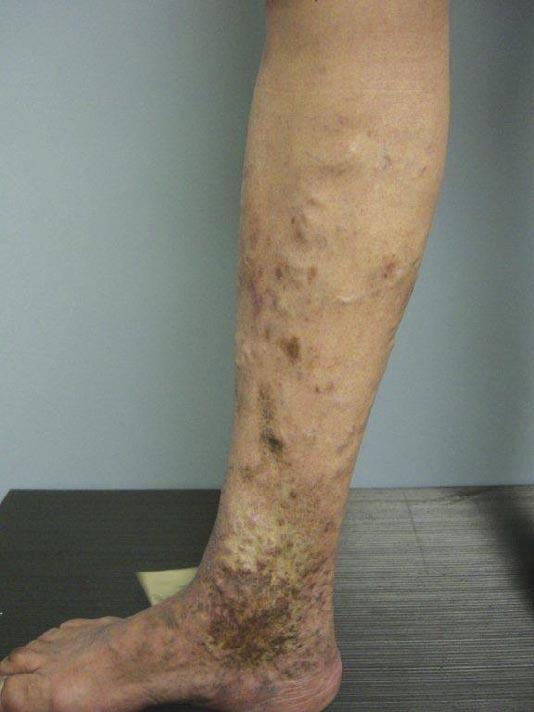
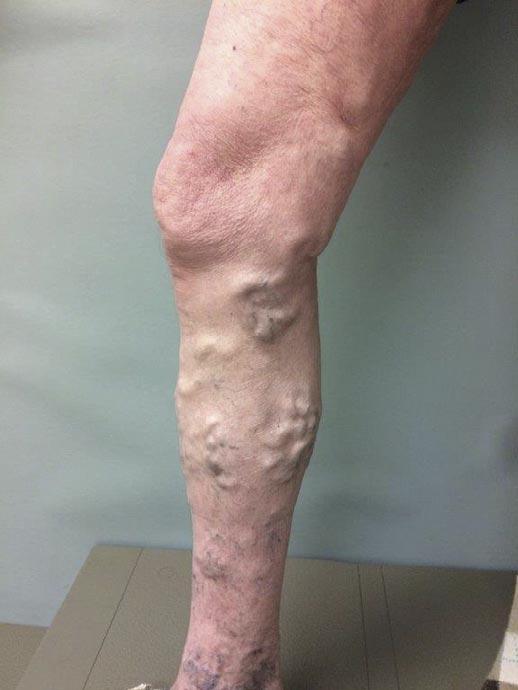

Dr. Robert K. Thompson III, is the Director of Veintec Varicose Vein Clinics-Hardy Oak location. He graduated from the University of Tennessee College of Medicine. He completed his general surgery residency at The University of Texas Health Science Center, San Antonio, Texas, and his vascular surgery fellowship at Baylor University Medical Center in Dallas, Texas. Dr. Thompson is Board-Certified in General Vascular Surgery and is a fellow of the American College of Surgeons.

Visit us at www.bcms.org 21 MEN’S HEALTH
Photography courtesy of Dr. Robert K. Thompson
New Diabetes Garage Workshop Making an Impact Among Men in San Antonio
By The City of San Antonio Metropolitan Health District
Aman with diabetes attended his first diabetes education class since he got diagnosed. In this peer-led session called The Diabetes GarageSM , he learned about portion sizes, the process of breaking down glucose after eating, and general information on how insulin works. He informed the program staff that this session has also motivated him to cut down on portion sizes.
Launched in early 2023, the Diabetes Garage workshops were implemented by the San Antonio Metropolitan Health District (Metro Health) to reduce diabetic hospitalizations and amputations amongst men. The four-week workshop includes a curriculum that uses car maintenance and automotive care analogies to describe how men with diabetes should take care of their bodies. Men who complete the workshop series receive a $20 H-E-B Gift Card and a red toolbox full of items to care for both their cars and bodies. Each session is once a week for two hours.
National Men’s Health Month is recognized during the month of June. During this time, Metro Health continues to remind men of the importance of taking care of their bodies by eating healthy and exercising to prevent chronic diseases such as diabetes.

Diabetes is one of the most common and burdensome diseases in San Antonio, particularly amongst men. Being the seventh leading cause of death in Bexar County, diabetes can be often missed or undiagnosed and lead to serious medical complications. Men are hospitalized for diabetes complications at a higher rate than females. In 2021, approximately 3,000 men were hospitalized due to this chronic disease. They also experience hospitalizations for diabetic amputations at more than double the rate when compared to females. Mortality rates are seen to be the highest among Black and Hispanic/Latino males.
After the first couple of sessions of the Diabetes Garage workshops,
22 SAN ANTONIO MEDICINE • June 2023 MEN’S HEALTH
A short story on how Metro Health is leading the way to a healthier community for men with diabetes.
the Diabetes Prevention and Control Program at Metro Health has seen improvement in the overall quality of life of the men who have participated.
A participant of the Diabetes Garage stated his doctor was impressed by his progress after finishing the workshops. Another participant said he began to use more natural seasonings on his meals to reduce sodium and sugar.
Education and support are the biggest challenges when someone is striving to make a lifestyle change, especially treating a chronic disease such as diabetes. A lack of a larger support system to connect and learn from others can lead to lesser education on how to treat this disease.
With a comprehensive community-approach and through its SA Forward Plan, Metro Health will continue expanding its peer-led diabetes prevention and control program to address food insecurity, nutrition and diabetes in Bexar County.
The COVID-19 pandemic exposed many gaps and required a bold public health response. Informed by pandemic lessons learned, Metro Health is addressing health disparities exposed during the pandemic by meeting the needs of the most marginalized neighborhoods while fostering resilience and healing. This includes addressing the status of diabetes in San Antonio and Bexar County, particularly in men.
Metro Health will continue to provide diabetes prevention education, along with other chronic disease prevention resources (such as nutrition education and promotion of healthy living), in the areas of San Antonio and Bexar County that have been impacted the most by COVID-19. The next Diabetes Garage session will begin on Wednesday, June 7, from 1 to 3 p.m. at the Doris Griffin Senior Center.
A community-led approach and engagement through key entities are essential to finding solutions that will eradicate health disparities. The Diabetes Prevention and Control program will also partner with the YMCA to offer a Men's Health Fair on Saturday, June 17 from 9 a.m. to 2 p.m. at the Walzem YMCA and Equity Hub. This fair will feature a 3-on-3 basketball tournament, produce giveaways, cooking demos and community vendors. The event will also promote upcoming Diabetes Garage sessions, which are planned to be hosted later this year.
For more information and to register for more no-cost workshops in Bexar County, the community can visit www.diabeteshelpsa.com.
At Metro Health, our mission is to prevent illness, promote healthy behaviors, and protect against environmental health hazards. As the City’s community health strategist, Metro Health is committed to eliminating historically rooted social and racial disparities in health through innovative practices and partnerships, while building a robust and resilient workforce, and making our public health more responsive to communities as they confront future health threats. For more information, visit www.sanantonio.gov/health.

Visit us at www.bcms.org 23 MEN’S HEALTH
Relationships and Heart Health
By Natalie R. Nyren, PA-C and Kit Bjella Kevin Powers, MD
If you think that having a stellar LDL cholesterol level is the ticket to enjoying a long healthy life, think again. Research in the field of positive psychology, the study of positive emotions and how they affect health, shows growing evidence that having strong meaningful relationships significantly impacts our well-being. In addition to managing personal cardiovascular risk factors (such as smoking, obesity, excess alcohol use and being sedentary), managing the quality of personal relationships and fostering positive emotions can significantly reduce the risk of cardiovascular events, such as heart attacks and strokes, and overcoming other ailments as we age1
The absence of illness or disease does not guarantee that one is well and living in an optimal state of health. According to the World Health Organization, health is defined as “a state of complete physical, mental and social well-being and not merely the absence of disease or infirmity”2. So, what does it mean to be in a complete state of well-being, and how do we get there?
Most research focuses on what causes or prevents disease. Much less research has been focused on what produces a state of optimal wellbeing. The relatively new fields of positive psychology and the study of longevity are growing and studies that show benefits of this approach are promising—even optimistic.
The Nun Study, which analyzed autobiographical essays submitted
at the start of the sisterhood of 180 nuns were evaluated and scored for the amount of positive emotional content expressed in the essays. Approximately 60 years later, those with the highest scores were found to have lived significantly longer than those who did not. Overall researchers found that the nuns with the most positive emotions lived on average 10 years longer than their less positive counterparts3.
In Boston, the longest ongoing longitudinal study has been tracking health-related outcomes since 1939. This study, The Harvard Study of Adult Development, includes over 700 men who were recruited from Harvard University and the surrounding Boston area. Throughout the past 75 years, the study consistently has shown that the most important predictor of happiness was the quality of social connections of the participants5. This landmark study also found that loneliness was the greatest predictor of premature death, increased pain, and an earlier onset of chronic disease5. Professor Robert Waldinger, the current director of the Harvard study states, “Loneliness kills. It’s as powerful as smoking or alcoholism”6. The majority of Americans report being lonely at some point in their lives, and it is becoming apparent that this is a bigger health concern than previously considered6
The benefits of strong social connections are many, including improving longevity, greater resistance to infections, improving our brain function and memory, as well as better management of chronic conditions such as heart disease1.
A study done in Japan on positive emotions and having a sense of purpose showed a significant increase risk of death from cardiovascular disease in those who had the least sense of purpose1. Another study in the U.S. showed that individuals with a higher sense of purpose had a lower risk of heart attack among a group with known coronary artery disease1,7.
Reduction of stress and reduction of stress-related pathophysiological responses are key factors in

24 SAN ANTONIO MEDICINE • June 2023 MEN’S HEALTH
deriving benefits from social relationships. In addition, healthy relationships encourage positive health behaviors and discourage maladaptive or counterproductive behaviors (e.g., smoking, alcohol and lack of physical activity). Numerous studies have shown that social relationships and social support networks have a favorable impact on numerous health-related outcomes, including morbidity and mortality from cardiovascular disease. For example, a study of marital status showed that all of the unmarried states (single never married, separated/divorced or widowed) were associated with more adverse cardiovascular outcomes, with the exception of widowed women. Interestingly, there were notable gender-differences in men vs. women in these studies: the riskiest category for men was single, never married, and for women separated/divorced. Across the board, however, men were more affected than women in terms marital status and health8 .
According to Robert Waldinger, relationships can be difficult. Waldinger suggests maintaining healthy social connections is akin to participating in regular physical exercise weekly. It takes effort on the individual to reach out to family and friends in order to maintain strong bonds, and the focus is not the quantity of relationships but the quality. Even a few close relationships can have significant benefits on our longevity and overall health. For example, a meaningful marriage can help alleviate the day-to-day stressors and ups and downs in life. Individuals who volunteer on a regular basis have been shown to live longer and healthier lives1. Even if you are single and not able to volunteer, consider micro-moments of connection for practicing simple acts of kindness for others, such as acknowledgement of others around you with a smile or simple wave. Sometimes we need to start small to build up our relationship muscles.
Lastly, remember you are not unique if you have experienced feelings of loneliness. The majority of Americans, up to 63% of men and 58% of women, have reported this condition6. In the age of rapidly advancing technology and smart devices, we must remember to nurture relationships, and make this a regular priority just as much as eating a healthy diet and regular exercise. Park N. et al, said it best, “A happy, engaged and fulfilling life is not a result of good health, but it is what creates a long healthy life”1. So, don’t forget to consider your relationships when you are assessing your wellness routine. In the long run, your heart will thank you!
References:
1. Park N, Peterson C, Szvarca D, Vanger Molen RJ, Kim ES, Collon K. Positive psychology and physical health: research and applications. Am J Lifestyle Med. 2016:10(3):200-2006
2. The World Health Organization Constitution. https://www.who. int/about/governance/constitution#:~:text=Health%20is%20a%2 0state%20of,belief%2C%20economic%20or%20social%20condition. Accessed 2023
3. Danner DD, Snowdon DA, Friesen VW, Positive emotions in early life and longevity: findings from the nun study. J Pers Soc Psychol. 2000;80:804-813
4. Saner E., Forget regret! How to have a happy life – according to the world’s leading expert. The Guardian. https://www.theguardian. com/lifeandstyle/2023/feb/06/how-to-have-a-happy-life-according-to-the-worlds-leading-expert. Accessed 2023

5. Grant WT. Study of adult development. Harvard Second Generation Study. 2015. https://www.adultdevelopementstudy.org/ grantdlueckstudy. Accessed 2023
6. The loneliness epidemic persists: A post pandemic look at the state of loneliness among U.S. adults. https://newsroom.thecignagroup. com/loneliness-epidemic-persists-post-pandemic-look#:~:text= Young%20adults%20are %20twice%20as,seniors%20aged%2066% 20and%20older. Accessed 2023
7. Kim ES, Sun JK, Park N, Kubzansky LD, Peterson C. Purpose in life and reduced risk of myocardial infarction among older U.S. adults with coronary artery disease: a two year follow up. J Behav Med. 2013;36(2):124-133

8. Gerard John Molloy,a, ∗ Emmanuel Stamatakis,b Gemma Randall,b and Mark Hamer.b Marital status, gender and cardiovascular mortality: Behavioural, psychological distress and metabolic explanations☆ Soc Sci Med. 2009 Jul; 69(2): 223–228
Natalie Nyren, PA-C, is a physician assistant who works in an outpatient cardiology clinic at University Health in San Antonio, Texas. She is Board-Certified in Lifestyle Medicine and is a certified clinical culinary coach who is dedicated to helping her patients achieve optimal health and wellness through evidence-based lifestyle interventions. With over 10 years of experience in the field, she is passionate about empowering individuals to take control of their health by making sustainable lifestyle changes.
Kit Bjella Powers, MD, FACC, FASE is a Board-Certified cardiologist who has been practicing in the greater San Antonio area for the last seven years. He is the medical director of Cardiology for University Medical Associates with locations at the Texas Diabetic Institute and at the UH Dominion Crossing office. He has focused on non-invasive and general cardiology and has special expertise in echocardiography. Dr. Powers also serves on the Board of the San Antonio Chamber Choir and has an undergraduate degree in Music.

Visit us at www.bcms.org 25 MEN’S HEALTH
Colon Cancer Rates in African American Males
By Victoria Ayodele, Contributing author Yousef Salem
In 2020, the whole world was shocked when Chadwick Boseman, also known as Marvel’s Black Panther, passed away from colon cancer at the age of 42. The announcement of his death became the most liked tweet of all time and Google searches for colon cancer soared by nearly 500%1. In recent years, colon cancer rates in younger adults (less than 50 years of age) have started to increase2. More particularly, the prevalence of colon cancer in African American males was brought to light by Boseman’s passing. Compared to other racial/ethnic groups, African American males are known to have the highest prevalence of colon cancer, being 24% more likely to develop colon cancer with a 47% higher mortality rate than their Caucasian counterparts3 The goal of this article is to provide a brief overview and explanation for the disparity in colon cancer prevalence between African American males and other demographic groups.
Colon cancer is the second leading cause of cancer-related deaths in the United States. The general prognosis for colon cancer is typically better than other malignancies, with a five-year survival rate of about 64% for non-metastatic disease. The etiology of colon cancer is thought to be multifactorial, secondary to both inherited genes and mutations caused by environmental influences4. However, the reasons why African American males are more severely impacted than other racial groups are still poorly understood. A 2007 study theorized that there was a connection between diets common among many African Americans and colon cancer by showing changes in their colonic bacteria that increased cancer risk. Additionally, they discovered that the African American participants who had higher colonic cell proliferation also had higher BMIs, supporting a link between obesity and a higher risk of colon cancer5. Other factors such as sedentary behavior, smoking and excessive alcohol consumption have also been associated with an
increased risk of colon cancer. African American males and other marginalized groups, particularly those of lower socioeconomic status, may be at increased risk for these reasons as well as they are more likely to engage in the aforementioned behaviors4.

Despite increasing rates in younger patients, the prognosis for colon cancer is improving thanks to the wider adoption of colonoscopy screening. However, the prognosis and outcomes in African American males continue to lag behind every other group, partially owing to low screening rates. In comparison to Caucasians, who are 61% likely to get screened for colon cancer, African Americans fall short at only 55.5%. According to a study by Mitchell et al., African American men were considerably less likely to have been screened for colon cancer if they did not routinely see a doctor6. There are a number of plausible reasons why some African American males may neglect seeing a doctor regularly, including access-related issues, mistrust of physicians, history of discrimination, lack of social support, lack of transportation, and a lack of insurance.
Aside from colon cancer, African American males are also disproportionately affected by other diseases such as hypertension and diabetes, likely due to some of the factors mentioned previously. Addressing healthcare disparities in African American males will require a multifaceted strategy that includes increased social support, better access to healthcare coverage, preventative care and other supportive factors. In the meantime, the death of Chadwick Boseman ignited a conversation about colon cancer. With increased awareness and screening, the prognosis of colon cancer in African American men can significantly improve. As we move forward, we must ensure that we normalize discussing health disparities in African American males in order to promote better health outcomes.
26 SAN ANTONIO MEDICINE • June 2023 MEN’S HEALTH
References:
1. Naik, H, Johnson, MDD, & Johnson, MR (2021, June 15). Internet interest in colon cancer following the death of Chadwick Boseman: Infoveillance Study. Journal of Medical Internet Research. Retrieved April 18, 2023, from https://www.jmir.org/ 2021/6/e27052/
2. Weinberg, BA, & Marshall, JL (2019, January 18). Colon cancer in Young Adults: Trends and their implications - current oncology reports. SpringerLink. Retrieved April 18, 2023, from https://link.springer.com/article/10.1007/s11912-019-0756-8
3. American Cancer Society. (nd). Cancer facts & figures for African Americans 2019-2021. Retrieved April 20, 2023, from https://www.cancer.org/content/dam/cancer-org/research/cancerfacts-and-statistics/cancer-treatment-and-survivorship-facts-andfigures/cancer-treatment-and-survivorship-facts-and-figures-20192021.pdf
4. Colorectal cancer: statistics. Cancer.Net. (2023, February). Retrieved April 18, 2023, from https://www.cancer.net/cancertypes/colorectal-cancer/statistics
5. O'Keefe, SJD, Chung, D, Mahmoud, N, Sepulveda, AR, Manafe, M, Arch, J, Adada, H, & van der Merwe, T (2007, January 1). Why do African Americans get more colon cancer than native Africans?.
Elsevier. Retrieved April 18, 2023, from https://www.sciencedirect.com/science/article/pii/S0022316622090320?via%3Dihub#s 0020
6. Rogers, CR, Matthews, P, Xu, L, Boucher, K, Riley, C, Huntington, M, Le Duc, N, Okuyemi, KS, & Foster, MJ (2020). Interventions for increasing colorectal cancer screening uptake among African-American men: A systematic review and meta-analysis. PloS one, 15(9), e0238354. https://doi.org/10.1371/journal.pone.0238354

Victoria Ayodele is a medical student at Long School of Medicine, Class of 2026. She is passionate about reducing healthcare disparities.

Yousef Salem is a medical student at Long School of Medicine in the Class of 2024 with an interest in health disparities.

Visit us at www.bcms.org 27 MEN’S HEALTH
Primary Care Role in Preventing Strokes in Men
By Morgan Lockwood, Corynne McEachern, Madisyn Moak
n the year 2019 in the United States, someone died of a stroke every three minutes and 30 seconds1. According to the Center for Disease Control and Prevention, stroke is the leading cause of death in men in the U.S. In fact, it has been shown that when compared to women of the same age, men were more likely to suffer a stroke2.
The American Stroke Association lists the different types of strokes as ischemic strokes, hemorrhagic strokes, transient ischemic attacks, cryptogenic strokes and brain stem strokes3. Compared to women, men are more likely to have an intracerebral hemorrhage4, and the most common cause is uncontrolled high blood pressure. Other risk factors include excessive alcohol use and cigarette smoking3. These are examples of modifiable risk factors, which are measures that can be changed by a person to help reduce their risk of disease5. Some examples of non-modifiable risk factors for stroke include family history of stroke, sex and age.
Hypertension is the most modifiable risk factor for stroke6. Early intervention is important as long-term complications may include seizures, bowel and bladder incontinence, cognitive impairment, as well as psychological effects7. As stated by Sarikaya et al., reducing a patient’s systolic blood pressure by only 2mmHg is associated with a 25% stroke risk reduction. Lifestyle modifications can be used prior to starting medication, such as increasing physical activity and reducing salt intake. An increase in one point in body mass index may be correlated with a 5% increase in stroke risk, which is why encouraging lifestyle modifications are an important tool used in the primary care setting for stroke prevention. In the instance that lifestyle modifications fail, the primary care physician may prescribe medications. Calcium antagonists and angiotensin-converting enzyme blockers have been shown to be helpful in controlling blood pressure6.
Motivational interviewing is “an evidence-based approach to behavior change”8 that can be used in primary care to inquire about a patient’s use of alcohol and cigarettes, and encourage cessation. According to the Center for Disease Control and Prevention, men are more likely to smoke than women and are also more likely to drink heavily.
The primary care doctor is in an integral position to inform patients of their risks and help them make appropriate changes. In other words, it falls on the primary care physician to promote stroke prevention and treat risk factors such as hypertension that may be difficult to control with lifestyle modification alone.
References:
1. American Heart Association. (2022). 2022 Heart Disease and Stroke Statistics Update Fact Sheet. Retrieved April 16, 2023, from
https://www.heart.org/-/media/PHD-Files-2/Science-News/2/2022Heart-and-Stroke-Stat-Update/2022-Stat-Update-At-aGlance.pdf#:~:text=In%202019%2C%20stroke%20accounted%20for%20 approximately%201%20of,3%20minutes%2030%20seconds%20in%20the %20United%20States
2. Centers for Disease Control and Prevention. (2022). Men and Stroke. Retrieved April 16, 2023, from https://www.cdc.gov /stroke/men.htm
3. American Stroke Association. (2023). Types of Stroke and Treatment. Retrieved April 16, 2023, from https://www.stroke.org/en /aboutstroke/types-of-stroke
4. Rexrode, KM, Madsen, TE, Yu, AYX, Carcel, C, Lichtman, JH & Miller, EC (2022). The Impact of Sex and Gender on Stroke. Circulation research, 130(4), 512–528. https://doi.org/10.1161/CIRCRESAHA.121.319915
5. UCSF Health. (2022, June 24). Understanding your risk for heart disease. ucsfhealth.org. Retrieved April 16, 2023, from https://www.ucsfhealth.org/ education/understanding-your-risk-for-heart-disease
6. Sarikaya, H, Ferro, J & Arnold, M (2015). Stroke prevention--medical and lifestyle measures. European neurology, 73(3-4), 150–157. https://doi.org/10.1159/000367652
7. Chohan, SA, Venkatesh, PK & How, CH (2019). Long-term complications of stroke and secondary prevention: an overview for primary care physicians. Singapore medical journal, 60(12), 616–620. https://doi.org/10.11622/ smedj.2019158
8. Understanding motivational interviewing. Understanding Motivational Interviewing | Motivational Interviewing Network of Trainers (MINT). (n.d.). Retrieved April 16, 2023, from https://motivationalinterviewing.org /understanding-motivational-interviewing
Morgan Lockwood is an OMS-III at the University of the Incarnate Word School of Osteopathic Medicine. She received a Bachelor of Science degree and Masters of Arts degree in Biology at Oakland University, and aspires to be a primary care physician, specializing in family medicine.


Corynne McEachern is in her third year at the University of the Incarnate Word School of Osteopathic Medicine, and will be pursuing family medicine. She graduated from Aurora University with a Bachelor of Science in both Biology/Pre-Med and Health Science.
Madisyn Moak is in her third year at the University of the Incarnate Word School of Osteopathic Medicine, and is pursuing a career in primary care. She graduated from the University of California Merced with a degree in Biology.

28 SAN ANTONIO MEDICINE • June 2023 MEN’S HEALTH
I

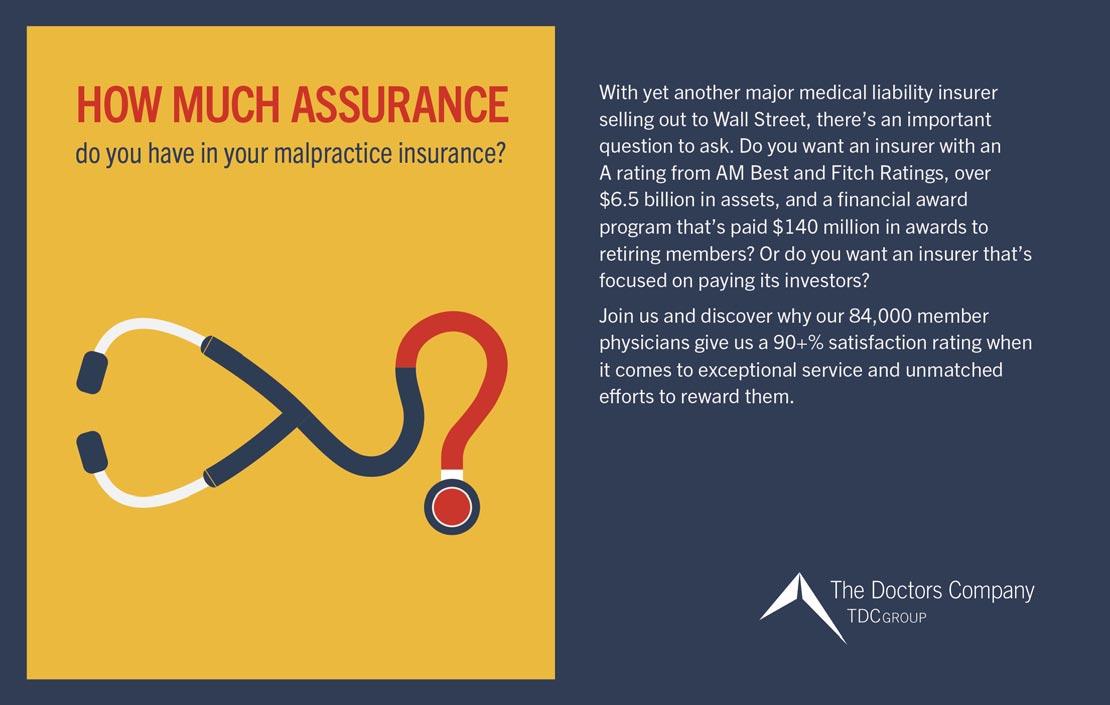
Visit us at www.bcms.org 29
A Season of Change: What It’s Like to Graduate Medical School in 2023
By Niva Shrestha, third-year medical student at UIWSOM
San Antonio is home to two medical schools: UT Health Long School of Medicine (Long SOM) and the University of the Incarnate Word School of Osteopathic Medicine (UIWSOM). Between both schools, that accounts for nearly 400 fourth-year medical students and soon-to-be newly minted doctors.
Spring marked the beginning of the end of the academic year. While completing another school year is exciting for many students at any level, nothing is quite like completing medical school and the exciting new possibilities that lay ahead.
This spring, two major events happened for graduating medical students: the Match in March and graduation in May. For over 70 years, the Match has been a stress-inducing national algorithm that plagues fourth years and “matches” students to a residency program in the United States. The process is akin to not wanting to be picked last for dodgeball in grade school.
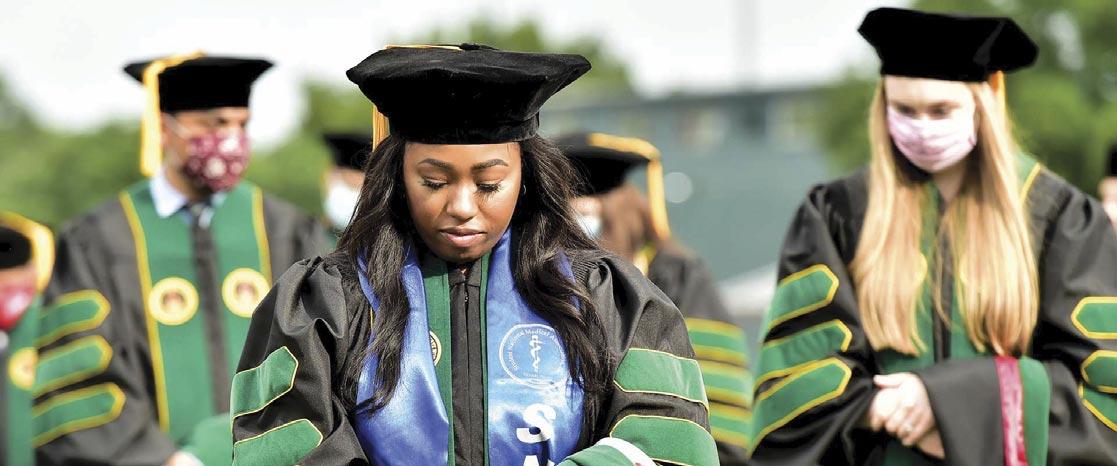
Every year the Match occurs in March.
What many don’t understand is that this is a weeklong event. On the Monday of Match Week, all applicants receive a letter stating if they matched to a residency program or not. At this point, matched applicants won’t know their residency program yet. On the flip side, unmatched applicants can apply for unfilled residency positions until the Thursday of Match Week—this is known as the SOAP (Supplemental Offer and Acceptance Program). On Friday of Match Week, everyone finds out what program they matched into. Graduation is guaranteed, matching isn’t. For Dawson Crane, a fourth-year medical student at Long SOM, “matching into his specialty of choice is much more meaningful to him than graduation itself.” Matching is the last big hurdle of medical school.
Before looking forward, we need to look back at the last four years. The Class of 2023 has lived through a pandemic, learned medicine virtually, seen national laws passed changing the healthcare field overnight, witnessed
the increasing politicization of medicine, and been privy to transforming innovations in treating diseases like obesity. Reflecting on their fourth year of medical school, both Dawson and Fernando Tejeda-Castro, a fourthyear at UIWSOM, look back fondly on their years of medical school in San Antonio.
I’ve really enjoyed my years at UIWSOM. However, it was physically and mentally exhausting at times, given how rigorous medical school can be. It was particularly challenging during the pandemic because we had to transition to virtual learning. In-person classes and tests were put on an indefinite hiatus. Not seeing classmates, friends and family was by far the most challenging aspect. Fortunately, by the time our third year rolled around, we could continue our clinical rotations, and things started to return to normal. Overall, I’m fortunate to have gone to UIWSOM and proud of myself and my classmates for making it to this point. It wasn’t an easy journey. -Fernando Tejeda-Castro,
UIWSOM Class of 2023
30 SAN ANTONIO MEDICINE • June 2023 SAN ANTONIO MEDICINE
After four years, I am grateful for the experiences that UTHSCSA was able to give me. It is an excellent medical school, and I feel as prepared as I can be to graduate and become a resident. UT Health does not sugarcoat anything. I remember Dr. Kellaway saying things like we wouldn’t have time to call our parents, and they shouldn’t bother us with calls. At the time, this sounded like an exaggeration to me, but to be fair, many times, that was true. I appreciated their honesty, and as tough as it always was, I always felt like Long had my back if I needed their help. As far as San Antonio goes, I could not have asked for a better city to train in. Coming from a smaller town, I loved all the opportunities this city brought with it. I learned to love the city and will forever be grateful for all the lessons San Antonio and its people have taught me. -Dawson
Crane,
Long SOM Class of 2023
Entering April, gone is the stress of March, and the reality of finally being a doctor is setting in. Graduating medical students can breathe easily and have much to look forward to.
May brings the promise and excitement of graduation, not just for the students graduating but also for their loved ones who have supported them on this incredible journey. While Match Day is for the students, graduation is for their family and loved ones. They say it takes a village to raise a child. Similarly, it takes a village to birth a doctor. Medical school can be difficult, lonely and long but many students, fortunately, have a strong support system that has helped them reach this point. Graduation this year was held on May 6, 2023 for UIWSOM and on May 21, 2023 for Long SOM.
Due to the COVID-19 pandemic, graduations across the nation have looked different in the last few years. Graduations have either been virtual, delayed or canceled altogether. This year, along with graduations, we also celebrate the official end of the COVID pandemic as of May 11, 2023. Happily, there were no public health restrictions this year, and students were free to invite as many family and friends as they wanted!
With June comes summer and a season of change. Whether moving, vacationing, getting married or catching up on sleep, this will be the new doctors’ last break and their last summer before residency starts on July 1.
Come July, residency and beyond!
Congratulations, Class of 2023, you did it!!
Niva Shrestha is a third-year medical student at UIWSOM and a member of the BCMS Publications Committee.

Special thanks to Dawson and Fernando for their help with this article.
For residency, Dawson will be going to UTMB for anesthesiology in Galveston, TX, and Fernando will be going to Einstein in Philadelphia, Pennsylvania for emergency medicine.
Opposite page: UIW School of Osteopathic Medicine. Above, top: Long School of Medicine graduates. Above, bottom: A graduate of the inaugural class in the UIW School of Osteopathic Medicine smiles while crossing the stage after receiving his diploma. Credit: Bria Woods / San Antonio Report.


Visit us at www.bcms.org 31 SAN ANTONIO MEDICINE
The Last “First Tuesdays at the Capitol” of the Legislative Session
By Melody Newsom, BCMS Chief Executive Officer and Executive Director
May 2, 2023, was our last chance to educate our legislators in person during the last ‘First Tuesdays at the Capitol’ for this legislative session, which ends May 29. The last month of a legislative session is a full-court press by everyone working to get legislation heard and passed or blocked! Once again, dedicated physicians, residents, medical students and Alliance members from across Texas came to the Capitol to discuss the list of the most crucial topics of importance to medicine. Our group took a divide-andconquer approach by strategically dividing up some of the 13 scheduled meetings with our legislators or their lead staff between two groups and then finished the last five meetings of the day together.
Some of the discussions were reminders of the hot topics, including ensuring there are enough Graduate Medical Education (GME) spots for Texas medical school residents to stay in Texas; the scope of practice and the importance of the physician leading the medical teams; extending postpartum care from the current three months to 12 months for Medicaid recipients; maintaining the requirements for childhood vaccinations, etc. Some of the newer topics were ensuring patients receive serious and sensitive test results directly from their physician, not through a patient portal; stressing the importance of pediatricians administering childhood vaccinations so they do not miss the critical developmental screenings as they grow; ensuring Texas maintains a strong Texas Medical Board that protects Texas patients and upholds high ethical and professional standards for physicians and preserves the 2003 medical liability reforms; voting appropriately to ensure the best possible healthcare for Texans and making sure insurance companies have a sufficient panel of physicians in their health plan’s network; and so much more!
Many thanks to the attendees who made our visits a success: Darrell Baskin, MD, Neal Dalrymple, MD, Carmen Garza, MD, John Nava, MD, John Shepherd, MD; Alliance member Jenny Shepherd; Resident, Samantha Cermignano, MD, representing herself and the Children’s Hospital of San Antonio Resident (CHOSA) residency program; and Medical Student, Missy Teets Schuckenbrock, OMS-1 from the UIW School of Osteopathic Medicine.
To read more about the topics discussed with the legislators, go to www.texmed.org/advocacy and click on Key Issues. For local discussion on these and other legislative advocacy topics, consider joining the BCMS Legislative and Socioeconomics Committee by contacting Mary Nava at mary.nava@bcms.org.

32 SAN ANTONIO MEDICINE • June 2023 LEGISLATIVE NEWS
BCMS members attending the May 2 First Tuesdays visit to the Capitol pause for a photo outside the north entrance to the Capitol.



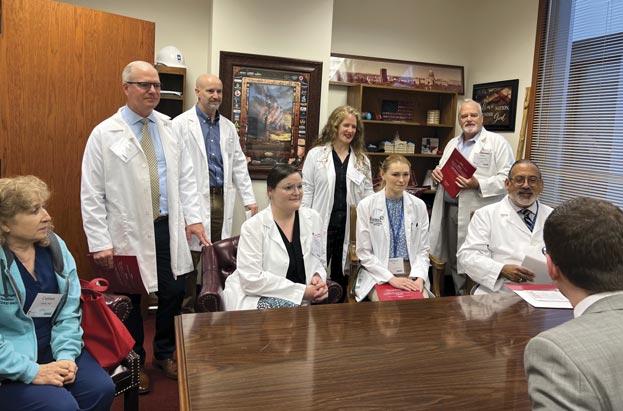
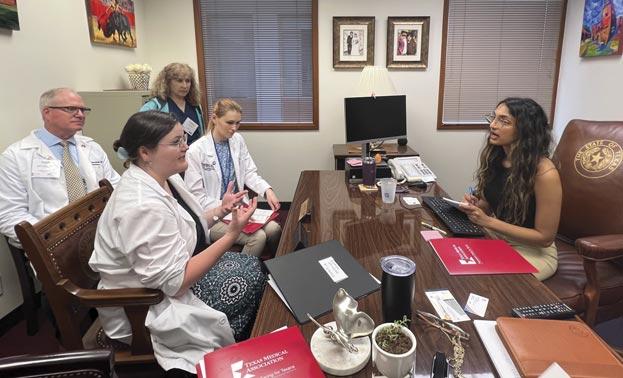
LEGISLATIVE NEWS Visit us at www.bcms.org 33
Jenny Shepherd, BCMS Alliance member and First Tuesdays at the Capitol Chair, addresses the last First Tuesdays at the Capitol attendees from all across Texas prior to going to the Capitol to meet with the state legislators.
Zack Dominguez, legislative staff member from the office of Rep. John Lujan (HD 118), visits with John Nava, MD, in the rotunda of the Texas capitol during the May 2 First Tuesdays visits.
BCMS physicians, a medical student, a resident and staff discuss issues of importance to medicine with Rep. Philip Cortez (HD 117) (standing center) during the May 2 First Tuesdays visit to the Capitol.
(l-r): Carmen Garza, MD; Neal Dalrymple, MD; Darrell Baskin, MD; Samantha Cermignano, MD; Emily Briggs, MD; Missy Teets Schuckenbrock, OMS-1 UIW; John Shepherd, MD; and John Nava, MD meet with Caleb Cashdollar, Chief of Staff for Rep. Mark Dorazio (HD 122) during the May 2 First Tuesdays visit to the Capitol.
On May 2, during the First Tuesdays visit to the Capitol, BCMS physicians and a medical student met with a legislative intern in the office of Rep. Lizabeth “Liz” Campos (HD 119).
Preparing for the Unexpected Trust and Estate Resources for Your Legacy
By Blake Bratcher, Vice President & Trust Officer at Texas Partners Bank

FIVE ESSENTIAL DOCUMENTS FOR CRAFTING AN ESTATE PLAN
You’ve diligently built your practice, and you’re building your legacy. Planning for the unexpected can be an uncomfortable topic and easy to put off doing. However, there are estate planning resources to help you effectively put together a game plan that will protect you and effectively allocate resources.
Our healthcare-focused expertise and proactive approach make it simple for you to steward your future with confidence. Here are the five essential documents we help guide you through to completion:
1. Last Will and Testament
This document communicates your final wishes and provides specific instructions about what to do with your assets upon your death.
2. Living Trust (Revocable)
This document allows for the transfer of your assets into a trust for your beneficiaries without needing to go through probate court proceedings. It is one way to manage your assets and protect your legacy should you become ill, disabled or faced with other challenges of growing older.
3. Durable Power of Attorney (POA)
This document gives someone else (your agent) permission to act on your behalf with financial matters in the event you are unable to do so.
4. Health Care Power of Attorney (POA)
This document gives someone else (your agent) permission to act on your behalf with medical matters if and when you are unable to speak for yourself.
5. Living Will
This is a legal document providing specific instructions for end-of-life care. It spells out how life-sustaining medical treatment decisions should be made if you’re incapacitated and cannot communicate them yourself.
Solidifying each of these documents is an essential part of a solid estate game plan.
Blake Bratcher, Vice President, Trust & Estate Officer at Texas Partners Bank, specializes in helping clients protect their legacies with confidence. His expertise in trust administration and corporate trustee services makes him an invaluable asset to the bank’s Private Banking department. Blake’s passion for honoring legacies and preserving family histories, combined with his legal background, enables him to provide clients with customized solutions that fit their unique needs and personal vision for their legacies.
As a neutral party, he helps families navigate relationships and prevents potential conflicts by educating and advising them about their financial management options. Blake’s dedication to authentic relationship building aligns with Texas Partners Bank’s values, fostering long-lasting, permanent relationships that families can rely on for generations. blake@texaspartners.bank
SAN ANTONIO MEDICINE 34 SAN ANTONIO MEDICINE • June 2023
TEXASPARTNERS.BANK | Member FDIC
In Memoriam
In honor and memory of Drs. Tamayo and Waller for their commitment and dedication.
Dr. Laura Rose Tamayo
February 8, 1970 - March 28, 2023
“Sicily Morning” by Oliver Johnson, Jr, MD
Dr. J.J. Waller, Jr.
March 21, 1931 - April 1, 2023
We were staying in a farmhouse in a vineyard in Sicily for a few days on a photoshoot, and I scouted over the mountain and discovered this idyllic valley. So, the next morning at 04:30 I packed my gear in a backpack, put on my headlamp and hiked over the mountain in the dark to set up my tripod before the sunrise. As the sun began to rise over the hills, the clouds obscured a potentially beautiful shot. But with patience, a break appeared in the clouds, the sun came streaming through and gave me this magnificent image.
Oliver Johnson, Jr, MD is a retired Anesthesiologist who dedicated 30 years to the medical field. Since 1995, he has chaired the BCMS Physicians Health and Rehabilitation Program. Dr. Johnson’s passion for photography takes him on photo trips around the world where he is surrounded by professional photographers who teach and advise. He currently shoots with a FUJIFILM X-T4 Mirrorless Camera.

Visit us at www.bcms.org 35
BCMS NEWS
UTSA Alvarez College of Business Executive MBA Program Kicks off the

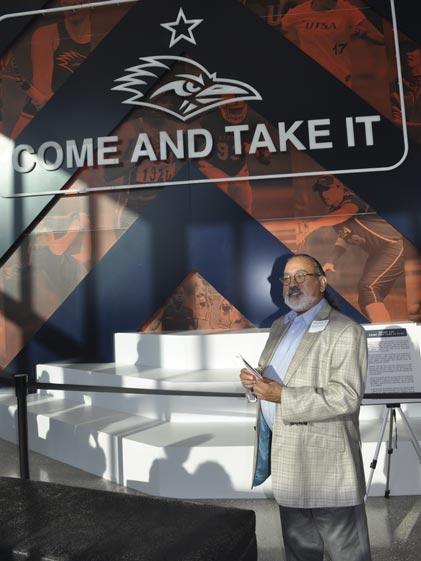

170th Anniversary Celebration of BCMS and its New Members

36 SAN ANTONIO MEDICINE • June 2023 BCMS EVENTS

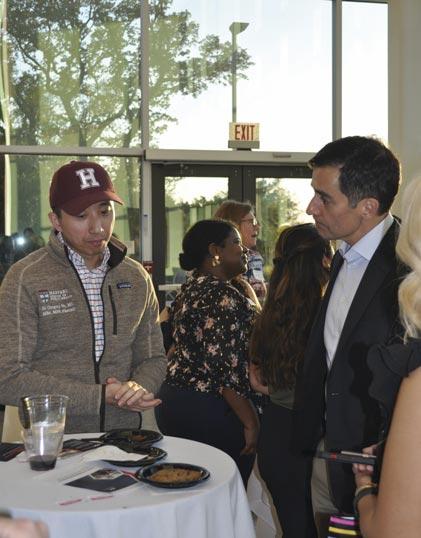



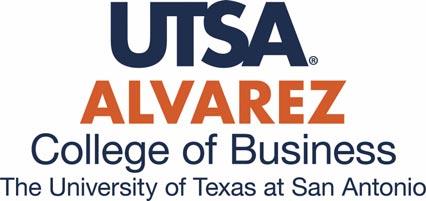
Visit us at www.bcms.org 37 BCMS EVENTS
Fiesta de Salud
By Monica Jones, BCMS COO
On April 19, 2023, our “Ask a Doctor” program participated in the Metro Health “Fiesta de Salud” at Crockett Park. We were strategically placed next to the Metro Health Vaccination Clinic from 3 to 7 pm.
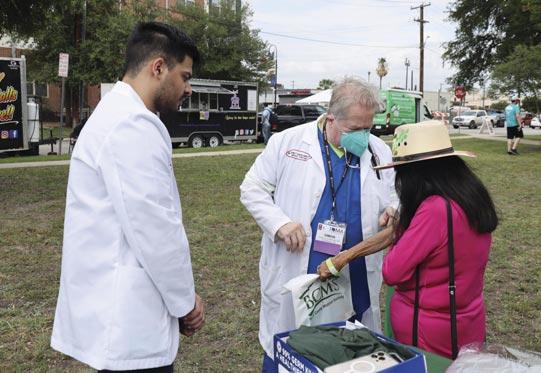
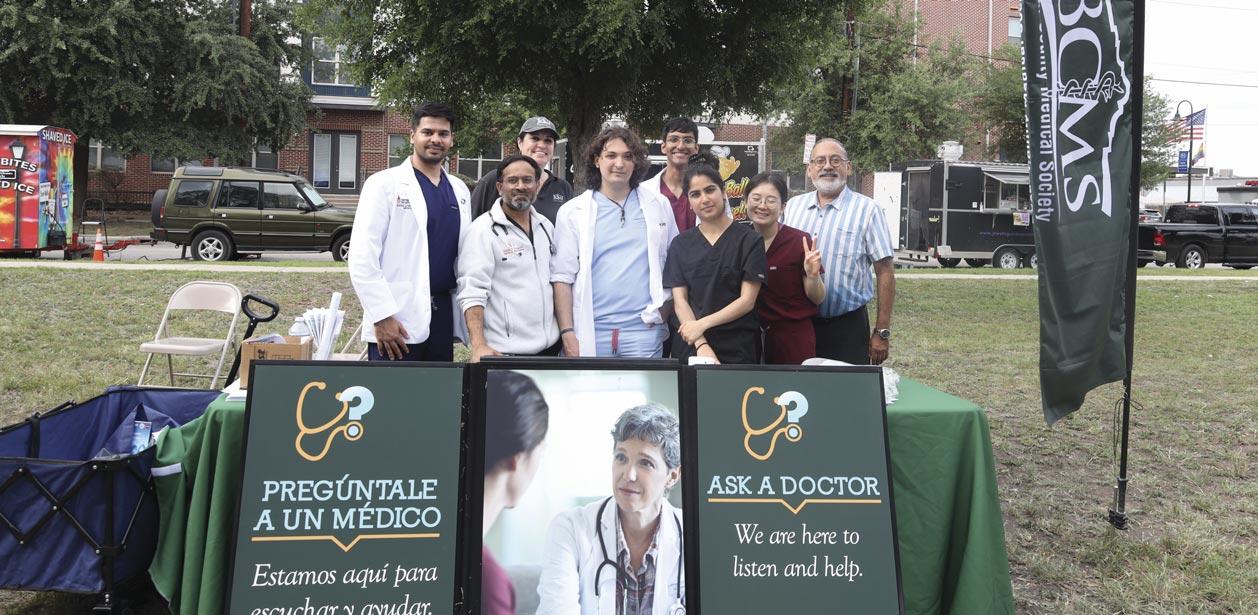
Metro Health did an amazing job providing not just COVID-19 and Flu shots, but provided Dtap, Polio, MCV4, Hib, MenB, MMR, Tdap, HepA and HepB. We were able to give about 16 COVID-19 vaccinations, three of which were children receiving their first shot. We also handed out 75 bags to attendees that visited our table filled with hand sanitizer, masks, Band-Aids and vaccination education.
During the “Fiesta de Salud,” BCMS was able to promote our vaccination outreach, education and partnership program through vaccination education during the event and provided vaccination hesitancy
literature by collaborating with Metro Health Vaccine clinic. THANK YOU to Dr. Simon Garza-Keever, Dr. Bhoja Katipally and Dr. John Nava. Special THANK YOU to our Medical Students from UIWSOM and UTHSCSA (Rahul Battula, Rodolfo Jarero, Tejinder Kaur, Yusef Khan, Jonathan Mathews, Esther Shin, Armaan Somaney and Jay Wang). Great Job Everyone!
The next BCMS "Ask A Doctor" table will be June 9, 2023 at the Summer in the City Cool Down & Wellness Festival presented by Health Confianza. If you are interested in volunteering to work future "Ask a Doctor" tables, please call Monica Jones at 210-301-4373 or email Monica.Jones@BCMS.org.
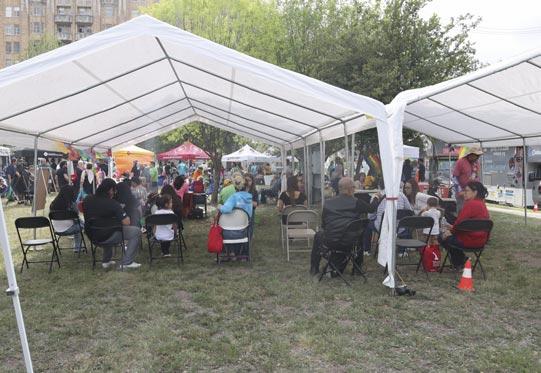
38 SAN ANTONIO MEDICINE • June 2023 BCMS EVENTS
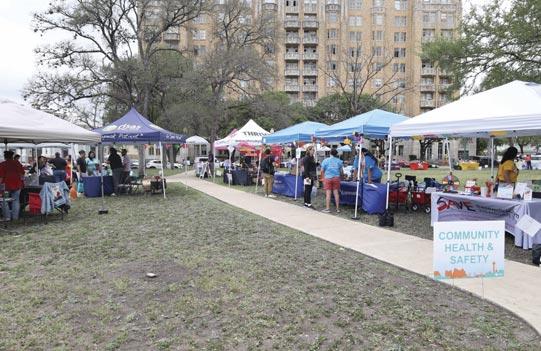
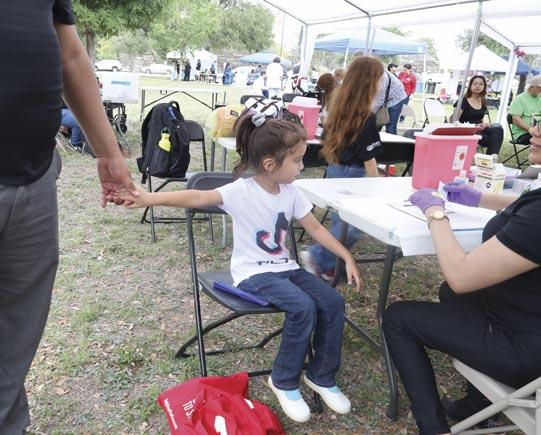




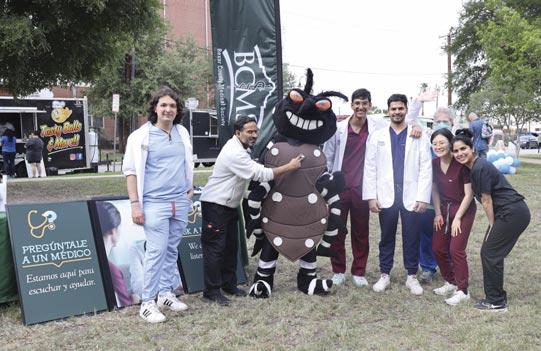
Visit us at www.bcms.org 39 BCMS EVENTS
Shop Vendors Who Support BCMS
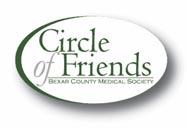
BCMS Vendor Directory
We encourage you to use our supporting vendors whenever you or your practice needs supplies or services.
ACCOUNTING FIRMS
Sol Schwartz & Associates P.C. (HHH Gold Sponsor)

Sol Schwartz & Associates is the premier accounting firm for San Antonio-area medical practices and specializes in helping physicians and their management teams maximize their financial effectiveness.
Jim Rice, CPA 210-384-8000, ext. 112 jprice@ssacpa.com www.ssacpa.com
“Dedicated to working with physicians and physician groups.”
ACCOUNTING SOFTWARE
ASSET WEALTH MANAGEMENT
Aspect Wealth Management (★★★ Gold Sponsor)

We believe wealth is more than money, which is why we improve and simplify the lives of our clients, granting them greater satisfaction, confidence and freedom to achieve more in life.
Michael Clark, President
210-268-1520
mclark@aspectwealth.com
www.aspectwealth.com
“Get what you deserve … maximize your Social Security benefit!”
BANKING
Express Information Systems (HHH Gold Sponsor)

With over 29 years’ experience, we understand that real-time visibility into your financial data is critical. Our browser-based healthcare accounting solutions provide accurate, multi-dimensional reporting that helps you accommodate further growth and drive your practice forward.
Rana Camargo
Senior Account Manager
210-771-7903
ranac@expressinfo.com www.expressinfo.com
“Leaders in Healthcare Software & Consulting”
ATTORNEYS
Kreager Mitchell (HHH Gold Sponsor)
At Kreager Mitchell, our healthcare practice works with physicians to offer the best representation possible in providing industry specific solutions. From business transactions to physician contracts, our team can help you in making the right decision for your practice.
Michael L. Kreager
210-283-6227
mkreager@kreagermitchell.com
Bruce M. Mitchell
210-283-6228
bmitchell@kreagermitchell.com
www.kreagermitchell.com
“Client-centered legal counsel with integrity and inspired solutions”

Broadway Bank (HHH Gold Sponsor)

Healthcare banking experts with a private banking team committed to supporting the medical community.
Thomas M. Duran
SVP, Private Banking Team Lead 210-283-6640
TDuran@Broadway.Bank www.broadwaybank.com
“We’re here for good.”
Denise Smith
Vice President | Private Banking
210-343-4502
Denise.C.Smith@amegybank.com
Scott Gonzales Assistant Vice President | Private Banking
210-343-4494
Scott.Gonzales@amegybank.com
www.amegybank.com
“Community banking partnership”
Synergy Federal Credit Union (HH Silver Sponsor)
Looking for low loan rates for mortgages and vehicles? We've got them for you. We provide a full suite of digital and traditional financial products, designed to help Physicians get the banking services they need.
Synergy FCU Member Services
210-750-8333 info@synergyfcu.org www.synergyfcu.org
“Once a member, always a member. Join today!”
CLINICAL DIAGNOSTICS
always at the peak of current technology.
Yulia Leontieva
Managing Partner, Physician Liaison
(210) 503-0003
yulia@genicslabs.com
Kevin Setanyan
Managing Partner
(210) 503-0003
kevin@genicslabs.com
Artyom Vardapetyan
Managing Partner
(210) 503-0003
www.genicslabs.com
“Accurate results in record time.”
CREDENTIALS VERIFICATION ORGANIZATION
Bexar Credentials Verification, Inc. (HHHH 10K Platinum Sponsor)
Bexar Credentials Verification Inc. provides primary source verification of credentials data that meets The Joint Commission (TJC) and the National Committee for Quality Assurance (NCQA) standards for health care entities.

Betty Fernandez
Director of Operations
210-582-6355
The Bank of San Antonio (HHH Gold Sponsor)

We specialize in insurance and banking products for physician groups and individual physicians. Our local insurance professionals are some of the few agents in the state who specialize in medical malpractice and all lines of insurance for the medical community.
Brandi Vitier
210-807-5581
brandi.vitier@thebankofsa.com
www.thebankofsa.com
Amegy Bank of Texas (HH Silver Sponsor)
We believe that any great relationship starts with five core values: Attention, Accountability, Appreciation, Adaptability and Attainability. We work hard and together with our clients to accomplish great things.
Robert Lindley
SVP | Private Banking Team Lead
210-343-4526
Robert.Lindley@amegybank.com
Livingston Med Lab (HHHH 10K Platinum Sponsor) High Complexity Clia/Cola accredited Laboratory providing White Glove Customer Service. We offer a Full Diagnostic Test Menu in the fields of Hematology, Chemistry, Endocrinology, Toxicology, Infectious Disease & Genetics. Robert Castaneda (CEO)

210-316-1792
Robert@livingstonmedlab.com
Joey Martinez (Director of Operations) 210-204-7072
Joey@livingstonmedlab.com
Dwight Chapman (Account Manager)
210-591-2649
Dwight@livingstonmedlab.com
www.livingstonmedlab.com/home
“Trusted Innovative, Accurate, and STAT Medical Diagnostics”
Betty.Fernandez@bexarcv.com
www.BexarCV.com
“Proudly serving the medical community since 1998”
FINANCIAL ADVISORS
Oakwell Private Wealth Management (HHHH 10K Platinum Sponsor)

Oakwell Private Wealth Management is an independent financial advisory firm with a proven track record of providing tailored financial planning and wealth management services to those within the medical community.
Brian T. Boswell, CFP®, QKA
Senior Private Wealth Advisor
512-649-8113
SERVICE@OAKWELLPWM.COM
www.oakwellpwm.com
Genics Laboratories (HHH Gold Sponsor)

Genics Laboratories offers accurate, comprehensive and reliable results to our partners and patients. Genics Laboratories is committed to continuous research, ensuring our protocols are
“More Than Just Your Advisor, We're Your Wealth Management Partner”
Elizabeth Olney with Edward Jones (HH Silver Sponsor)
We learn your individual needs so we can develop a strategy to help you achieve your financial goals.
40 SAN ANTONIO MEDICINE • June 2023
Join the nearly 7 million investors who know. Contact me to develop an investment strategy that makes sense for you.
Elizabeth Olney
Financial Advisor
210-858-5880
Elizabeth.olney@edwardjones.com www.edwardjones.com/elizabeth-olney
"Making Sense of Investing"
FINANCIAL SERVICES
jsanderson@nhsltd.com
Nexus Neurorecovery Center 227 Lewis St, San Antonio, TX 78212
https://nexushealthsystems.com
“To return patients to lives of productivity and meaning”
sional reporting that helps you accommodate further growth and drive your practice forward.
Rana Camargo
Senior Account Manager
210-771-7903
ranac@expressinfo.com
www.expressinfo.com
“Leaders in Healthcare Software & Consulting”
INSURANCE
Aspect Wealth Management (HHH Gold Sponsor)

We believe wealth is more than money, which is why we improve and simplify the lives of our clients, granting them greater satisfaction, confidence and freedom to achieve more in life.
Michael Clark, President 210-268-1520 mclark@aspectwealth.com www.aspectwealth.com
“Get what you deserve … maximize your Social Security benefit!”
GERIATRICS/PRIMARY CARE
Provider's Choice Scribe Services (HHH Gold Sponsor)

Our accurate and complete documentation helps our customers focus on what’s most important, their patients. Let us take on the task of documenting your patient encounters, it’s what we do.
Yoceline Aguilar COO
yaguilar@pcscribes.com
915-691-9178
Luis Chapa
MD/CEO
210-796-4547
lchapa@pcscribes.com
www.providerschoicess.com/
“An Unparalleled Scribe Experience”
TMA Insurance Trust
(HHHH 10K Platinum Sponsor)
TMA Insurance Trust is a full-service insurance agency offering a full line of products – some with exclusive member discounts and staffed by professional advisors with years of experience. Call today for a complimentary insurance review. It will be our privilege to serve you.

Wendell England Director of Member Benefits
512-370-1776
wendell.england@tmait.org
800-880-8181
www.tmait.org
“We offer BCMS members a free insurance portfolio review.”
The Bank of San Antonio Insurance Group, Inc. (HHH Gold Sponsor)

We specialize in insurance and banking products for physician groups and individual physicians. Our local insurance professionals are some of the few agents in the state who specialize in medical malpractice and all lines of insurance for the medical community.
Katy Brooks, CIC 210-807-5593
katy.brooks@bosainsurance.com
www.thebankofsa.com
“Serving the medical community.”
MedPro Group (HH Silver Sponsor)
Rated A++ by A.M. Best, MedPro Group has been offering customized insurance, claims and risk solutions to the healthcare community since 1899. Visit MedPro to learn more.
Kirsten Baze 512-658-0262
Kirsten.Baze@medpro.com www.medpro.com
INVESTMENT ADVISORY REAL ESTATE
Conviva Care Center (HHH Gold Sponsor)

Conviva’s value-based care model allows physicians to deliver high quality, personalized care and achieve better outcomes, while feeling free to focus on health equity and patient outcomes.
Kim Gary Senior Physician Recruiter (812) 272-9838
KGary4@humana.com www.ConvivaCareers.com
“Fuel Your Passion & Find Your Purpose”
HOSPITALS/ HEALTHCARE FACILITIES
UT Health San Antonio MD Anderson Cancer Center (HHH Gold Sponsor)

UT Health provides our region with the most comprehensive care through expert, compassionate providers treating patients in more than 140 medical specialties at locations throughout San Antonio and the Hill Country.
UT Health San Antonio Physicians
Regina Delgado
Business Development Manager (210) 450-3713
delgador4@uthscsa.edu
UT Health San Antonio MD
Anderson Mays Cancer Center
Laura Kouba
Business Development Manager (210) 265-7662
norriskouba@uthscsa.edu
https://uthscsa.edu/
Appointments: 210-450-1000
UT Health San Antonio
Humana
(HHH Gold Sponsor)
Humana is a leading health and well-being company focused on making it easy for people to achieve their best health with clinical excellence through coordinated care.
Jon Buss: 512-338-6167
Jbuss1@humana.com
Shamayne Kotfas: 512-338-6103 skotfas@humana.com
www.humana.com
INSURANCE/MEDICAL MALPRACTICE
Nexus Neurorecovery Center (HHH Gold Sponsor)

A post-acute rehabilitation facility focusing on brain injuries. Programming provides individual and group physical, occupational, cognitive and speech therapy. We help residents return to lives of productivity and meaning.
Sydney Kerr, Liaison 346-339-2654
skerr@nhsltd.com
Caitlyn Tewksbury ctewksbury@nhsltd.com
Justin Sanderson, CEO
210-854-4732
7979 Wurzbach Road San Antonio, TX 78229
INFORMATION AND TECHNOLOGIES
Express Information Systems (HHH Gold Sponsor)

With over 29 years’ experience, we understand that real-time visibility into your financial data is critical. Our browser-based healthcare accounting solutions provide accurate, multi-dimen-
Texas Medical Liability Trust
(HHHH 10K Platinum Sponsor)
With more than 20,000 healthcare professionals in its care, Texas Medical Liability Trust (TMLT) provides malpractice insurance and related products to physicians. Our purpose is to make a positive impact on the quality of healthcare for patients by educating, protecting, and defending physicians.

Patty Spann
512-425-5932
patty-spann@tmlt.org
www.tmlt.org
Recommended partner of the Bexar County Medical Society
Alamo Capital Advisors LLC

(★★★★ 10K Platinum Sponsor)
Alamo Capital Advisors is focused on Sourcing, Capitalizing, and Executing investment and development opportunities for our investment partners and providing thoughtful solutions to our advisory clients. Current projects include new development acquisitions and sales, lease representation and financial (RE)-structuring for existing investments.
Jon Wiegand, Principal 210-241-2036
jw@alamocapitaladvisors.com
www.alamocapitaladvisors.com
MEDICAL BILLING AND COLLECTIONS SERVICES
Wave Online (★★★ Gold Sponsor)

Our team of professionals will act as your extended AR office enhancing your revenue through our proprietary metrics and claim management systems. In addition, you keep 100% control of your RCM. Contact us today for a no cost evaluation.
Visit us
continued on page 42
at
41
www.bcms.org
BCMS Vendor
Saranraj (Raj) Venkatesh
Vice President – RCM | Sales and Client Relations
726-228-1097
saranraj@wavemt.com
https://rcmwave.com/ “Innovation towards Solutions”
Commercial & Medical Credit Services (HH Silver Sponsor)
A bonded and fully insured San Antonio-based collection agency.
Henry Miranda 210-340-9515
hcmiranda@sbcglobal.net www.cmcs-sa.com
“Make us the solution for your account receivables.”
MEDICAL SUPPLIES AND EQUIPMENT
Henry Schein Medical (HH Silver Sponsor)
From alcohol pads and bandages to EKGs and ultrasounds, we are the largest worldwide distributor of medical supplies, equipment, vaccines and pharmaceuticals serving office-based practitioners in 20 countries. Recognized as one of the world’s most ethical companies by Ethisphere.
Tom Rosol 210-413-8079
tom.rosol@henryschein.com www.henryschein.com
“BCMS members receive GPO discounts of 15 to 50 percent.”
MILITARY
San Antonio Army Medical Recruiting office (★★Silver Sponsor)
Mission: Recruit highly qualified and motivated healthcare professionals for service in the Army Reserves or Active Duty Army, in support of Soldiers and their families.
1LT Thomas Alexandria 210-328-9022
Alexandria.n.thomas12.mil@army. mil
https://recruiting.army.mil/mrb/ “Service to Country, Army Medicine, Experientia et Progressus”
PRACTICE MANAGEMENT
best performance. Contact us today for a no cost evaluation.
Saranraj (Raj) Venkatesh Vice President – RCM | Sales and Client Relations
726-228-1097
saranraj@wavemt.com
https://rcmwave.com/ “Innovation towards Solutions”
PROFESSIONAL ORGANIZATIONS
The Health Cell (HH Silver Sponsor)
“Our Focus is People” Our mission is to support the people who propel the healthcare and bioscience industry in San Antonio. Industry, academia, military, nonprofit, R&D, healthcare delivery, professional services and more!
Kevin Barber President
210-308-7907 (Direct) kbarber@bdo.com
Valerie Rogler Program Coordinator
210-904-5404
Valerie@thehealthcell.org
www.thehealthcell.org
“Where San Antonio’s Healthcare Leaders Meet”
San Antonio Medical Group Management Association (SAMGMA) (HH Silver Sponsor)
SAMGMA is a professional nonprofit association with a mission to provide educational programs and networking opportunities to medical practice managers and support charitable fundraising.
Lindsey Herman Nolan, MHR, CMPE President
info4@samgma.org
www.samgma.org
REAL ESTATE SERVICES COMMERCIAL
RETIREMENT PLANNING
Oakwell Private Wealth Management

(HHHH 10K Platinum Sponsor)
Oakwell Private Wealth Management is an independent financial advisory firm with a proven track record of providing tailored financial planning and wealth management services to those within the medical community.
Brian T. Boswell, CFP®, QKA
Senior Private Wealth Advisor 512-649-8113 SERVICE@OAKWELLPWM.COM
www.oakwellpwm.com
“More Than Just Your Advisor, We're Your Wealth Management Partner”
STAFFING SERVICES
Favorite Healthcare Staffing (HHHH 10K Platinum Sponsor)

Serving the Texas healthcare community since 1981, Favorite Healthcare Staffing is proud to be the exclusive provider of staffing services for the BCMS. In addition to traditional staffing solutions, Favorite offers a comprehensive range of staffing services to help members improve cost control, increase efficiency and protect their revenue cycle.
Cindy M. Vidrine Director of Operations- Texas 210-918-8737
cvidrine@favoritestaffing.com
“Favorite Healthcare Staffing offers preferred pricing for BCMS members.”
TRANSCRIPTION SERVICES
Provider's Choice Scribe Services (★★★ Gold Sponsor)

Our accurate and complete documentation helps our customers focus on what’s most important, their patients. Let us take on the task of documenting your patient encounters, it’s what we do.
Yoceline Aguilar COO
yaguilar@pcscribes.com
915-691-9178
Luis Chapa MD/CEO
210-796-4547
lchapa@pcscribes.com
www.providerschoicess.com/ “An Unparalleled Scribe Experience”
Wave Online (★★★ Gold Sponsor)

Professional Analysis focusing on Low Collections, High Denials Rates. Our Business Intelligence tools will identify Cash Pockets and Cash Leakages. With a 360degree view on your practices’ financials, we can tune your AR for
Alamo Capital Advisors LLC (

★★★★ 10K Platinum Sponsor)
Alamo Capital Advisors is focused on Sourcing, Capitalizing, and Executing investment and development opportunities for our investment partners and providing thoughtful solutions to our advisory clients. Current projects include new development acquisitions and sales, lease representation and financial (RE)-structuring for existing investments.
Jon Wiegand Principal 210-241-2036
jw@alamocapitaladvisors.com
www.alamocapitaladvisors.com
42 SAN ANTONIO MEDICINE • June 2023
Directory continued from page 41
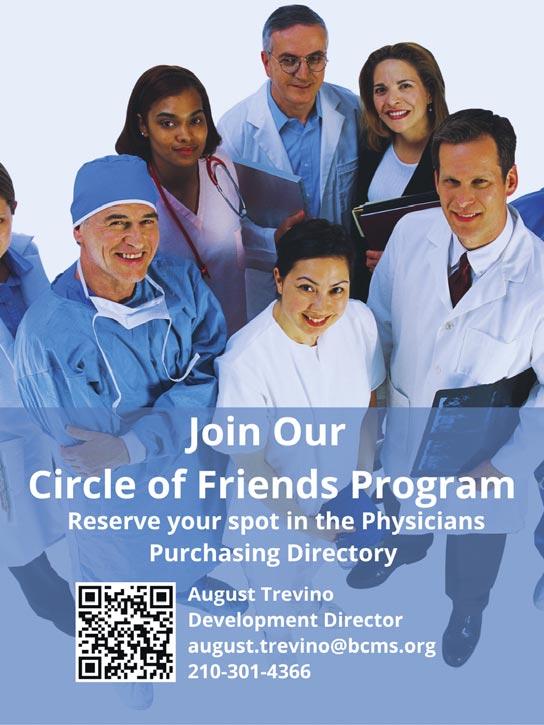


Visit us at www.bcms.org 43
2023 Mercedes-AMG SL 63




 By Stephen Schutz, MD
By Stephen Schutz, MD
AUTO REVIEW 44 SAN ANTONIO MEDICINE • June 2023
The 2023 Mercedes-AMG SL 63 is a top-shelf convertible that offers outstanding performance, advanced technology and opulent comfort. With its striking design, powerful engine and high-quality features, the SL 63 is an excellent choice for those who seek the best in terms of luxury and performance.
The current SL generation, the seventh, launched in 2022 and is a significant departure from all other previous SLs in that it now comes with four seats rather than just two. No adult would ever want to sit in the rear two seats, but young children would be fine back there, and that space is great for luggage.
Of note, the Mercedes SL’s main competitor is the Porsche 911, which has included four seats since its introduction in 1963. Presumably, Mercedes had the 911 in mind when they created the newest SL.
The 2023 SL is expensive whether you select the AMG 55 (about $140k) or AMG 63 ($180k-ish) versions, with the 63 providing more power and performance. Both SL models are powered by a twin-turbo 4.0-liter V-8; the SL 55’s engine makes 469 HP, and upgrading to an SL 63 like my press car bumps that figure up to 577 HP. A nine-speed automatic is the only available transmission, and an all-wheel-drive system and four-wheel steering are standard on all SL models.
Driving the SL 63 is exhilarating, as you’d expect, with the sporty Mercedes capable of accelerating from 0 to 60 MPH in just 3.5 seconds. In the real world that means that passing other vehicles on the interstate or a backcountry road is the opposite of challenging.
The 2023 Mercedes-AMG SL 63’s handling is equally impressive, thanks to a sophisticated suspension, the aforementioned rear-wheelsteering, and a low center of gravity. The car feels planted and composed around corners, providing excellent grip and stability even at high speeds. The low center of gravity is helped by the switch from a hard-top convertible in the last SL to a soft-top in this generation, which subtracts weight from the top of the car. Nevertheless, at around 4,300 pounds, the SL is still heavy despite Mercedes’ extensive use of lightweight materials such as aluminum and magnesium in the construction of the car.
The SL 63 comes with multiple drive modes, including Comfort, Sport, Sport+ and Individual, allowing the driver to customize the driving experience. Switching among the modes can be done by turning a small dial attached to the steering wheel, a nice touch.
A relatively firm ride is part of the deal when you drive the SL 63, even when it’s in Comfort mode. Nobody expects a sports car to feel like a Lexus on the highway, but this generation SL rides firmer than the last one and is close to the ultra-sporty Mercedes AMG GT supercar. I wish it were softer.
The exterior design of the 2023 Mercedes-AMG SL 63 is sleek
and contemporary, with a long hood, wide grille and muscular lines that reflect its performance and elegance. The soft-top convertible roof helps here too, allowing for more styling flexibility than the hard-top, which must be shaped to fit into the trunk without bending when lowered.
While the soft-top roof improves the SL’s driving dynamics and exterior design, there’s no noticeable noise penalty. Mercedes’ engineers obviously paid special attention to insulation and soundproofing because the cabin is as quiet and comfortable as the previous hard-top SL when driving with the top up.
The interior of the SL 63 is, not surprisingly given its price tag, crafted with the finest materials and offers a wealth of luxury features. Supportive and comfortable seats wrapped in premium leather are standard, and the fact that the front seats are heated, ventilated and feature multiple adjustments, including massaging functions, means that customers can expect a high level of comfort on long outings. I took the SL 63 on three long drives and felt great during and after all three.
The cabin also features a dual-zone automatic climate control system, configurable ambient lighting and a power wind deflector when the top is down, adding to the overall comfort and convenience.
The technology in the 2023 Mercedes-AMG SL 63 is cutting-edge and comprehensive. It includes a fully digital instrument cluster that displays vital information in a crisp and clear manner, and a large infotainment system with an 11.9-inch touchscreen that offers a wide range of features, including navigation, audio controls, smartphone integration and more. The latest MBUX infotainment system also supports voice commands and has a user-friendly interface, making it easy to manage while on the go.
The Burmeister surround sound system, which I absolutely love, provides an immersive audio experience that elevates any drive.
The 2023 SL 63 is a very impressive car that will make previous SL owners happy, and yet also represents a viable alternative to the Porsche 911 thanks to its improved design and the addition of two rear seats. It’s expensive, but those who can afford it will enjoy it.
As always, call Phil Hornbeak, the Auto Program Manager at BCMS (210-301-4367) for your best deal on any new car or truck brand. Phil can also connect you to preferred financing and lease rates.
Stephen Schutz, MD, is a board-certified gastroenterologist who lived in San Antonio in the 1990s when he was stationed here in the U.S. Air Force. He has been writing auto reviews for San Antonio Medicine magazine since 1995.

AUTO REVIEW Visit us at www.bcms.org 45
11911 IH 10 West San Antonio, TX 78230
Coby Allen 210-696-2232
Audi Dominion 21105 West IH 10 San Antonio, TX 78257
Rick Cavender 210-681-3399
Northside Chevrolet 9400 San Pedro Ave. San Antonio, TX 78216
Charles Williams 210-912-5087
Chuck Nash Chevrolet Buick GMC 3209 North Interstate 35 San Marcos, TX
William Boyd 210-859-2719
Bluebonnet Chrysler Dodge Ram 547 S. Seguin Ave. New Braunfels, TX 78130
Matthew C. Fraser 830-606-3463
Auto Group
Northside Ford 12300 San Pedro San Antonio, TX
Marty Martinez 210-477-3472
Kahlig Auto Group
Northside Honda 9100 San Pedro Ave. San Antonio, TX 78216
Paul Hopkins 210-988-9644
Auto Group

14610 IH 10 West San Marcos, TX 78249
Mark Hennigan 832-428-9507
Land Rover San Antonio 13660 IH 10 West San Antonio, TX
Cameron Tang 210-561-4900
North Park Lexus 611 Lockhill Selma San Antonio, TX
Tripp Bridges 210-308-8900
North Park Lexus at Dominion 25131 IH 10 W Dominion San Antonio, TX
James Cole 210-816-6000
9455 IH 10 West San Antonio, TX 78230
Douglas Cox 210-764-6945
Kahlig Auto Group
Audi North Park 15670 IH-35 North Selma, TX 78254
Camden Steele 325-374-9897
North Park Lincoln 9207 San Pedro San Antonio, TX
Sandy Small 210-341-8841
North Park Subaru 9807 San Pedro San Antonio, TX 78216
Raymond Rangel 210-308-0200
North Park Mazda 9333 San Pedro San Antonio, TX 78216
John Kahlig 210-253-3300
North Park Subaru at Dominion 21415 IH 10 West San Antonio, TX 78257
Phil Larson 877-356-0476
Mercedes Benz of Boerne 31445 IH 10 West Boerne, TX
James Godkin 830-981-6000
Cavender Toyota 5730 NW Loop 410 San Antonio, TX
Gary Holdgraf 210-862-9769
Mercedes Benz of San Antonio 9600 San Pedro San Antonio, TX
Al Cavazos Jr. 210-366-9600
North Park Toyota 10703 Southwest Loop 410 San Antonio, TX 78211
Justin Boone 210-635-5000
 Kahlig
Kahlig
Kahlig Auto Group
Kahlig Auto Group
Kahlig Auto Group
Kahlig Auto Group
Kahlig
Kahlig
Kahlig Auto Group
Kahlig Auto Group
Kahlig Auto Group
Kahlig Auto Group
Call Phil Hornbeak 210-301-4367
email phil@bcms.org
Kahlig Auto Group
or
On
May 1, 2023, the loan rate will change from 4.25% WAC to 4.70% for 60 months with approved credit.













































































































 By Stephen Schutz, MD
By Stephen Schutz, MD


 Kahlig
Kahlig
Kahlig Auto Group
Kahlig Auto Group
Kahlig Auto Group
Kahlig Auto Group
Kahlig
Kahlig
Kahlig Auto Group
Kahlig Auto Group
Kahlig Auto Group
Kahlig Auto Group

